Revealing the Magmatic Impulse Emplacement and Evolution Path of Kimberlite in Southern Liaoning through Mineralogical Characteristics of the Phlogopite Zone
Abstract
1. Introduction
2. Geological Setting
3. Analytical Methods
3.1. Electron Probe Micro-Analysis of Phlogopite
3.2. X-ray Mapping of Phlogopite
3.3. LA–ICP–MS Analysis of Phlogopite
4. Petrography
4.1. Petrography of #50 Phlogopite
4.2. Petrography of #110 Phlogopite
5. Results
5.1. Low-Ti-Cr Core Composition of #50 Phlogopite
5.2. High-Ti-Cr Core/Inner Rim Composition of #50 Phlogopite
5.3. Low-Cr/Cr-Poor Outer Rim Composition of #50 Phlogopite
5.4. Rind I (Low-Ti-Cr) and Rind II (High-Ti-Cr) Composition of #50 Phlogopite
5.5. Composition of #110 Phlogopite
6. Discussion
6.1. Origin of the #50 Phlogopite Zone
6.1.1. Origin of #50 Low-Ti-Cr Phlogopite Cores
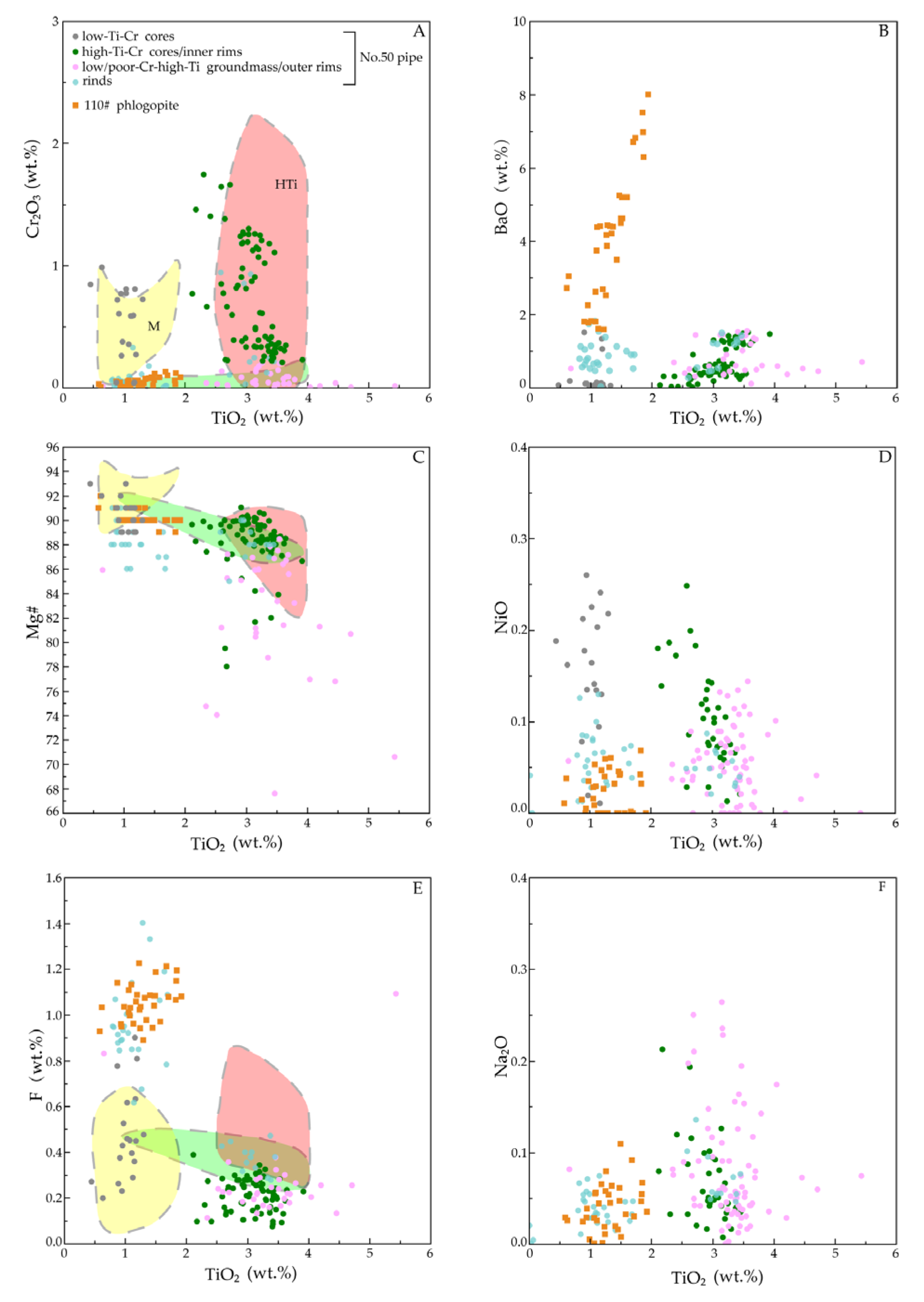
6.1.2. Origin of the #50 High-Ti-Cr Phlogopite Cores/Inner Rims
6.1.3. Origin of #50 Low-Cr/Cr-Poor Phlogopite Outer Rims
6.1.4. Origin of the #50 Phlogopite Rinds
6.2. Origin of the #110 Phlogopite
6.3. Lithology Determination of Pipe Nos. 50 and 110 Kimberlites
6.4. Kimberlite Emplacement Mechanism
7. Conclusions
Supplementary Materials
Author Contributions
Funding
Data Availability Statement
Acknowledgments
Conflicts of Interest
References
- Becker, M.; Le Roex, A.P. Geochemistry of South African on- and off-craton, group I and group II kimberlites: Petrogenesis and source region evolution. J. Petrol. 2006, 47, 673–703. [Google Scholar] [CrossRef]
- Giuliani, A.; Pearson, D.G.; Soltys, A.; Dalton, H.; Phillips, D.; Foley, S.F.; Lim, E.; Goemann, K.; Griffin, W.L.; Mitchell, R.H. Kimberlite Genesis from a Common Carbonate-Rich Primary Melt Modified by Lithospheric Mantle Assimilation. 2020. Available online: http://advances.sciencemag.org/ (accessed on 12 December 2022).
- Le Roex, A.P.; Bell, D.R.; Davis, P. Petrogenesis of group I Kimberlites from Kimberley, South Africa: Evidence from bulk-rock geochemistry. J. Petrol. 2003, 44, 2261–2286. [Google Scholar] [CrossRef]
- Mitchell, R.H. Kimberlites, Mineralogy, Geochemistry, and Petrology; Springer Science & Business Media: Berlin/Heidelberg, Germany, 1989. [Google Scholar]
- Woodhead, J.; Hergt, J.; Giuliani, A.; Maas, R.; Phillips, D.; Pearson, D.G.; Nowell, G. Kimberlites reveal 2.5-billion-year evolution of a deep, isolated mantle reservoir. Nature 2019, 573, 578–581. [Google Scholar] [CrossRef] [PubMed]
- Coe, N.; Roex, A.; Gurney, J.; Pearson, G.D.; Nowell, G. Petrogenesis of the Swartruggens and Star Group II kimberlite dyke swarms, South Africa: Constraints from whole rock geochemistry. Contrib. Mineral. Petrol. 2008, 156, 627–652. [Google Scholar] [CrossRef]
- Giuliani, A.; Phillips, D.; Woodhead, J.D.; Kamenetsky, V.S.; Fiorentini, M.L.; Maas, R.; Soltys, A.; Armstrong, R.A. Did diamond-bearing orangeites originate from MARID-veined peridotites in the lithospheric mantle? Nat. Commun. 2015, 6, 6837. [Google Scholar] [CrossRef] [PubMed]
- Nowell, G.M.; Pearson, D.G.; Bell, D.R.; Carlson, R.W.; Smith, C.B.; Kempton, P.D.; Noble, S.R. Hf isotope systematics of kimberlites and their megacrysts: New constraints on their source regions. J. Petrol. 2004, 45, 1583–1612. [Google Scholar] [CrossRef]
- Giuliani, A.; Phillips, D.; Kamenetsky, V.S.; Goemann, K. Constraints on kimberlite ascent mechanisms revealed by phlogopite compositions in kimberlites and mantle xenoliths. Lithos 2016, 240–243, 189–201. [Google Scholar] [CrossRef]
- Dawson, J.B.; Hawthorne, J.B. Intrusion Features of Some Hypabyssal South African Kimberlites. Bull. Volcanol. 1970, 34, 740–757. [Google Scholar] [CrossRef]
- Field, M.; Scott Smith, B.H. Contrasting Geology and Near-Surface Emplacement of Kimberlite Pipes in Southern Africa and Canada. In Extended Abstracts, Proceedings of the 7th International Kimberlite Conference, Cape Town, South Africa, 11–17 April 1998; Gurney, J.J., Pascoe, M.D., Richardson, S.H., Eds.; Red Roof Design: Cape Town, South Africa, 1999; pp. 214–237. [Google Scholar]
- Nowicki, T.; Crawford, B.; Dyck, D.; Carlson, J.; McElroy, R.; Oshust, P.; Helmstaedt, H. The geology of kimberlite pipes of the Ekati property, Northwest Territories, Canada. Lithos 2004, 76, 1–27. [Google Scholar] [CrossRef]
- Sparks, R.S.J. Kimberlite volcanism. Annu. Rev. Earth Planet Sci. 2013, 41, 497–528. [Google Scholar] [CrossRef]
- Clement, C.R. A Comparative Geological Study of Some MajorKimberlite Pipes in the Northern Cape and Orange Free State. Ph.D. Thesis, University of Cape Town, Cape Town, South Africa, 1982. [Google Scholar]
- Brooker, R.A.; Sparks, R.S.J.; Kavanagh, J.L.; Field, M. The volatile content of hypabyssal kimberlite magmas: Some constraints from experiments on natural rock compositions. Bull. Volcanol. 2011, 73, 959–981. [Google Scholar] [CrossRef]
- Kamenetsky, M.B.; Sobolev, A.V.; Kamenetsky, V.S.; Maas, R.; Danyushevsky, L.V.; Thomas, R.; Pokhilenko, N.P.; Sobolev, N.V. Kimberlite melts rich in alkali chlorides and carbonates: A potent metasomatic agent in the mantle. Geology 2004, 32, 845–848. [Google Scholar] [CrossRef]
- Kamenetsky, V.S.; Golovin, A.V.; Maas, R.; Giuliani, A.; Kamenetsky, M.B.; Weiss, Y. Towards a New Model for Kimberlite Petrogenesis: Evidence from Unaltered Kimberlites and Mantle Minerals. Earth-Science Reviews; Elsevier: Amsterdam, The Netherlands, 2014; pp. 145–167. [Google Scholar] [CrossRef]
- Nielsen, T.F.D.; Sand, K.K. The Majuagaa kimberlite dike, Maniitsoq region, West Greenland: Constraints on an Mg-rich silicocarbonatitic melt composition from groundmass mineralogy and bulk compositions. Can. Mineral. 2008, 46, 1043–1061. [Google Scholar] [CrossRef]
- Patterson, M.; Francis, D.; McCandless, T. Kimberlites: Magmas or mixtures? Lithos 2009, 112, 191–200. [Google Scholar] [CrossRef]
- Tappe, S.; Foley, S.F.; Jenner, G.A.; Heaman, L.M.; Kjarsgaard, B.A.; Romer, R.L. Genesis of ultramafic lamprophyres and carbonatites at Aillik Bay, Labrador: A consequence of incipient lithospheric thinning beneath the North Atlantic Craton. J. Petrol. 2006, 47, 1261–1315. [Google Scholar] [CrossRef]
- Reguir, E.P.; Chakhmouradian, A.R.; Halden, N.M.; Malkovets, V.G.; Yang, P. Major- and trace-element compositional variation of phlogopite from kimberlites and carbonatites as a petrogenetic indicator. Lithos 2009, 112, 372–384. [Google Scholar] [CrossRef]
- Larionova, Y.O.; Sazonova, L.V.; Lebedeva, N.M.; Nosova, A.A.; Tretyachenko, V.V.; Travin, A.V.; Kargin, A.V.; Yudin, D.S. Kimberlite age in the Arkhangelsk Province, Russia: Isotopic geochronologic Rb–Sr and 40Ar/39Ar and mineralogical data on phlogopite. Petrology 2016, 24, 562–593. [Google Scholar] [CrossRef]
- Downes, P.J.; Wartho, J.A.; Griffin, B.J. Magmatic evolution and ascent history of the Aries micaceous kimberlite, central Kimberley Basin, Western Australia: Evidence from zoned phlogopite phenocrysts, and UV laser 40Ar/39Ar analysis of phlogopite-biotite. J. Petrol. 2006, 47, 1751–1783. [Google Scholar] [CrossRef]
- Fritschle, T.; Prelević, D.; Foley, S.F.; Jacob, D.E. Petrological characterization of the mantle source of Mediterranean lamproites: Indications from major and trace elements of phlogopite. Chem. Geol. 2013, 353, 267–279. [Google Scholar] [CrossRef]
- Hunren, R.H.; Kissi-Tng, R.D.; Tnvlon, L.A. Mid-to Late-Stage Kimberlitic Melt Evolution: Phlogopites and Oxides from the Fayette County Kimberlite, Pennsylvania. American Mineralogist 1984. Available online: http://pubs.geoscienceworld.org/msa/ammin/article-pdf/69/1-2/30/4216842/am69_30.pdf (accessed on 27 November 2020).
- Mitchell, R.H. Kimberlites, Orangeites, and Related Rocks. Kimberlites, Orangeites, and Related Rocks; Springer: Berlin/Heidelberg, Germany, 1995. [Google Scholar] [CrossRef]
- O’Brien, H.E.; Irving, A.J.; Stewear McCallum, I. Cornplex zoning and resorption of phenocrysts in mixed potassic mafic magmas of the Highwood Mountains, Montana. Am. Mineral. 1988, 73, 1007–1024. [Google Scholar]
- Shee, S.R.; Bristow, J.W.; Shee, P.B.S.; Bell, D.R. The Petrogenesis of the Wesselton Mine Kimberlites, Kimberley, Cape Province, R.S.A. Ph.D. Thesis, University of Cape Town, Cape Town, South Africa, 1985; p. 220. [Google Scholar]
- Sobolev, N.V.; Logvinova, A.M.; Zedgenizov, D.A.; Pokhilenko, N.P.; Malygina, E.V.; Kuzmin, D.V.; Sobolev, A.V. Petrogenetic significance of minor elements in olivines from diamonds and peridotite xenoliths from kimberlites of Yakutia. Lithos 2009, 112, 701–713. [Google Scholar] [CrossRef]
- Sobolev, N.V.; Sobolev, A.V.; Tomilenko, A.A.; Kovyazin, S.V.; Batanova, V.G.; Kuz’min, D.V. Paragenesis and complex zoning of olivine macrocrysts from unaltered kimberlite of the Udachnaya-East pipe, Yakutia: Relationship with the kimberlite formation conditions and evolution. RGG 2015, 56, 260–279. [Google Scholar] [CrossRef]
- Howarth, G.H. Olivine megacryst chemistry, Monastery kimberlite: Constraints on the mineralogy of the HIMU mantle reservoir in southern Africa. Lithos 2018, 314–315, 658–668. [Google Scholar] [CrossRef]
- Howarth, G.H.; Gross, J. Diffusion-controlled and concentric growth zoning revealed by phosphorous in olivine from rapidly ascending kimberlite magma, Benfontein, South Africa. Geochim. Cosmochim. Acta 2019, 266, 292–306. [Google Scholar] [CrossRef]
- Howarth, G.H.; Taylor, L.A. Multi-stage kimberlite evolution tracked in zoned olivine from the Benfontein sill, South Africa. Lithos 2016, 262, 384–397. [Google Scholar] [CrossRef]
- Giuliani, A. Insights into kimberlite petrogenesis and mantle metasomatism from a review of the compositional zoning of olivine in kimberlites worldwide. Lithos 2018, 312–313, 322–342. [Google Scholar] [CrossRef]
- Tovey, M.; Giuliani, A.; Phillips, D.; Moss, S. Controls on the explosive emplacement of diamondiferous kimberlites: New insights from hypabyssal and pyroclastic units in the Diavik mine, Canada. Lithos 2020, 360, 105410. [Google Scholar] [CrossRef]
- Mitchell, R.H.; Giuliani, A.; O’Brien, H. What is a kimberlite? Petrology and mineralogy of hypabyssal kimberlites. Elements 2019, 15, 381–386. [Google Scholar] [CrossRef]
- Yang, Y.H.; Wu, F.Y.; Wilde, S.A.; Liu, X.M.; Zhang YBin Xie, L.W.; Yang, J.H. In situ perovskite Sr-Nd isotopic constraints on the petrogenesis of the Ordovician Mengyin kimberlites in the North China Craton. Chem. Geol. 2009, 264, 24–42. [Google Scholar] [CrossRef]
- Donnelly, C.L.; Griffin, W.L.; Yang, J.H.; O’Reilly, S.Y.; Li, Q.L.; Pearson, N.J.; Li, X.H. In situ U-Pb dating and Sr-Nd isotopic analysis of perovskite: Constraints on the age and petrogenesis of the Kuruman Kimberlite Province, Kaapvaal Craton, South Africa. J. Petrol. 2012, 53, 2497–2522. [Google Scholar] [CrossRef]
- Sarkar, C.; Storey, C.D.; Hawkesworth, C.J. Using perovskite to determine the pre-shallow level contamination magma characteristics of kimberlite. Chem. Geol. 2014, 363, 76–90. [Google Scholar] [CrossRef]
- Zhu, R.Z.; Ni, P.; Ding, J.Y.; Wang, G.G.; Fan, M.S.; Li, S.N. Metasomatic processes in the lithospheric mantle beneath the No. 30 kimberlite (Wafangdian region, North China craton). Can. Miner. 2019, 57, 499–517. [Google Scholar] [CrossRef]
- Zhu, R.Z.; Ni, P.; Ding, J.Y.; Wang, D.Z.; Ju, Y.; Kang, N.; Wang, G.G. Petrography, chemical composition, and Raman spectra of chrome spinel: Constraints on the diamond potential of the No. 30 pipe kimberlite in Wafangdian, North China Craton. Ore Geol. Rev. 2017, 91, 896–905. [Google Scholar] [CrossRef]
- Hoare, B.C.; O’Sullivan, G.; Tomlinson, E.L. Metasomatism of the Kaapvaal Craton during Cretaceous intraplate magmatism revealed by combined zircon U-Pb isotope and trace element analysis. Chem. Geol. 2021, 578, 120302. [Google Scholar] [CrossRef]
- Veglio, C.; Lawley, C.J.M.; Pearson, D.G.; Kjarsgaard, B.A.; Petts, D.C.; Jackson, S.E. Olivine xenocrysts reveal carbonated mid-lithosphere in the northern Slave craton. Lithos 2022, 414, 106633. [Google Scholar] [CrossRef]
- Moore, A.; Costin, G.; Proyer, A. Cognate versus xenocrystic olivines in kimberlites—A review. Earth Sci. Rev. 2021, 221, 103771. [Google Scholar] [CrossRef]
- Xing, C.M.; Wang, C.Y.; Charlier, B.; Namur, O. Ubiquitous dendritic olivine constructs initial crystal framework of mafic magma chamber. Earth Planet Sci. Lett. 2022, 594, 117710. [Google Scholar] [CrossRef]
- Li, D.; Wu, Z.; Sun, X.; Shuai, S.; Fu, Y.; Li, D.; Chen, H.; Lu, Y.; Hong, L. Emplacement ages of diamondiferous kimberlites in the Wafangdian District, North China Craton: New evidence from LA-ICP-MS U-Pb geochronology of andradite-rich garnet. Gondwana Res. 2022, 109, 493–517. [Google Scholar] [CrossRef]
- Dawson, J.B.; Smith, J.V. Chemistry and origin of phlogopite megacrysts in kimberlite. Nature 1975, 253, 336–338. [Google Scholar] [CrossRef]
- Foley, S. Vein-plus-wall-rock melting mechanisms in the lithosphere and the origin of potassic alkaline magmas. Lithos 1992, 28, 435–453. [Google Scholar] [CrossRef]
- Van Achterbergh, E.; Griffn, W.L.; Stiefenhofer, J. Metasomatism in mantle xenoliths from the Letlhakane kimberlites: Estimation of element fluxes. Contrib Miner. Petrol. 2001, 141, 397–414. [Google Scholar] [CrossRef]
- Grégoire, M.; Bell, D.; Le Roex, A. Trace element geochemistry of phlogopite-rich mafic mantle xenoliths: Their classification and their relationship to phlogopite-bearing peridotites and kimberlites revisited. Contrib. Mineral. Petrol. 2002, 142, 603–625. [Google Scholar] [CrossRef]
- Grégoire, M.; Rabinowicz, M.; Janse, A.J.A. Mantle mush compaction: A key to understand the mechanisms of concentration of kimberlite melts and initiation of swarms of kimberlite dykes. J. Petrol. 2006, 47, 631–646. [Google Scholar] [CrossRef]
- O’Reilly, S.Y.; Griffin, W.L. Mantle metasomatism. In Lecture Notes in Earth System Sciences; Harlov, D.E., Håkon, A., Eds.; Springer International Publishing: Berlin/Heidelberg, Germany, 2013; pp. 471–533. [Google Scholar] [CrossRef]
- Safonov, O.G.; Butvina, V.G. Indicator reactions of K and Na activities in the upper mantle: Natural mineral assemblages, experimental data, and thermodynamic modeling. Geochem. Int. 2016, 54, 858–872. [Google Scholar] [CrossRef]
- Kargin, A.V.; Sazonova, L.V.; Nosova, A.A.; Lebedeva, N.M.; Tretyachenko, V.V.; Abersteiner, A. Cr-rich clinopyroxene megacrysts from the Grib kimberlite, Arkhangelsk province, Russia: Relation to clinopyroxene–phlogopite xenoliths and evidence for mantle metasomatism by kimberlite melts. Lithos 2017, 292–293, 34–48. [Google Scholar] [CrossRef]
- Fu, H.T.; Wan, F.L.; Jiang, L.L.; Xu, H.; Li, Y.X.; Yang, L. Geological Characteristics of Kimberlites in Wafangdian Diamond Orefield, Liaoning Province. Acta Geosci. Sin. 2021, 42, 859–867. [Google Scholar] [CrossRef]
- Thompson, J.M.; Meffre, S.; Danyushevsky, L. Impact of air, laser pulse width and fluence on U-Pb dating of zircons by LA-ICPMS. J. Anal. At. Spectrom. 2018, 33, 221–230. [Google Scholar] [CrossRef]
- Paton, C.; Hellstrom, J.; Paul, B.; Woodhead, J.; Hergt, J. Iolite: Freeware for the visualisation and processing of mass spectrometric data. J. Anal. At. Spectrom. 2011, 26, 2508–2518. [Google Scholar] [CrossRef]
- Wang, S.; Zhang, J.; Han, S.; Wang, J. Petrography and petrogenesis of porphyritic kimberlite from South Liaoning. Acta Geol. Sin. 2020, 94, 2677–2686. [Google Scholar]
- Giuliani, A.; Phillips, D.; Kamenetsky, V.S.; Kendrick, M.A.; Wyatt, B.A.; Goemann, K.; Hutchinson, G. Petrogenesis of mantle polymict breccias: Insights into mantle processes coeval with kimberlite magmatism. J. Petrol. 2014, 55, 831–858. [Google Scholar] [CrossRef]
- Arndt, N.T.; Guitreau, M.; Boullier, A.M.; Le Roex, A.; Tommasi, A.; Cordier, P.; Sobolev, A. Olivine, and the origin of kimberlite. J. Petrol. 2010, 51, 573–602. [Google Scholar] [CrossRef]
- Pilbeam, L.H.; Nielsen, T.F.D.; Waight, T.E. Digestion fractional crystallization (DFC): An important process in the genesis of kimberlites. Evidence from olivine in the Majuagaa kimberlite, Southern West Greenland. J. Petrol. 2013, 54, 1399–1425. [Google Scholar] [CrossRef]
- Schulze, D.J. Origins of chromian and aluminous spinel macrocrysts from kimberlites in southern africa. Can. Mineral. 2001, 39, 361–376. [Google Scholar] [CrossRef]
- Kargin, A.V.; Sazonova, L.V.; Nosova, A.A.; Lebedeva, N.M.; Kostitsyn, Y.A. Phlogopite in mantle xenoliths and kimberlite from the Grib pipe, Arkhangelsk province, Russia: Evidence for multi-stage mantlemetasomatism and origin of phlogopite in kimberlite. Geosci. Front. 2019, 10, 1941–1959. [Google Scholar] [CrossRef]
- Wyllie, P.J. The origin of kimberlite. J. Geophys. Res. 1980, 85, 6902–6910. [Google Scholar] [CrossRef]
- Farmer, G.L.; Boettcher, A.L. Petrologic and crystal-chemical significance of some deep-seated phlogopitesl. Am. Mineral. 1981, 66, 1154–1163. [Google Scholar]
- Griffin, W.L.; Shee, S.R.; Ryan, C.G.; Win, T.T.; Wyatt, B.A. Harzburgite to Iherzolite and back again: Metasomatic processes in ultramafic xenoliths from the Wesselton kimberlite, Kimberley, South Africa. Contrib. Mineral. Petrol. 1999, 134, 232–250. [Google Scholar] [CrossRef]
- Beard, A.D.; Downes, H.; Hegner, E.; Sablukov, S.M. Geochemistry and mineralogy of kimberlites from the Arkhangelsk Region, NW Russia: Evidence for transitional kimberlite magma types. Lithos 2000, 51, 47–73. [Google Scholar] [CrossRef]
- Howarth, G.H.; Giuliani, A. Contrasting types of micaceous kimberlite-lamproite magmatism from the Man Craton (West Africa): New insights from petrography and mineral chemistry. Lithos 2020, 362, 105483. [Google Scholar] [CrossRef]
- Xiang, Z.; Yang, Z.; Lei, X. The microfabrics of phlogopite from the mengyin kimberlites and their implications to the magma evolution. Bull. Mineral. Petrol. Geochem. 2020, 39, 105–115. [Google Scholar] [CrossRef]
- Fedortchouk, Y.; Canil, D. Intensive variables in kimberlite magmas, Lac de Gras, Canada and implications for diamond survival. J. Petrol. 2004, 45, 1725–1745. [Google Scholar] [CrossRef]
- Smith, J.V.; Brennesholtz, R.; Dawson, J.B. Chemistry of micas from kimberlites and xenoliths-I. Micaceous kimberlites. Geochim. Cosmochim. Acta 1978, 42, 959–971. [Google Scholar] [CrossRef]
- Bussweiler, Y.; Foley, S.F.; Prelević, D.; Jacob, D.E. The olivine macrocryst problem: New insights from minor and trace element compositions of olivine from Lac de Gras kimberlites, Canada. Lithos 2015, 220–223, 238–252. [Google Scholar] [CrossRef]
- Lim, E.; Giuliani, A.; Phillips, D.; Goemann, K. Origin of complex zoning in olivine from diverse, diamondiferous kimberlites and tectonic settings: Ekati (Canada), Alto Paranaiba (Brazil) and Kaalvallei (South Africa). Miner. Pet. 2018, 112, 539–554. [Google Scholar] [CrossRef]
- Edgar, A.D.; Arima, M. Conditions of phlogopite crystallization in ultrapotassic volcanic rocks. Miner. Mag. 1983, 47, 11–19. [Google Scholar] [CrossRef]
- Beard, A.D.; Downes, H.; Hegner, E.; Sablukov, S.M.; Vetrin, V.R.; Balogh, K. Mineralogy and geochemistry of Devonian ultramafic minor intrusions of the southern Kola Peninsula, Russia: Implications for the petrogenesis of kimberlites and melilitites. Contrib. Miner. Petrol. 1998, 130, 288–303. [Google Scholar] [CrossRef]
- Gaspar, J.C.; Wyllie, P.J. Barium phlogopite from the Jacupiranga carbonatite, Brazil. Am. Mineral. 1982, 67, 997–1000. [Google Scholar]
- Shaikh, A.M.; Kumar, S.P.; Patel, S.C.; Thakur, S.S.; Ravi, S.; Behera, D. The P3 kimberlite and P4 lamproite, Wajrakarur kimberlite field, India: Mineralogy, and major and minor element compositions of olivines as records of their phenocrystic vs. xenocrystic origin. Miner. Pet. 2018, 112, 609–624. [Google Scholar] [CrossRef]
- Chepurov, A.I.; Zhimulev, E.I.; Agafonov, L.V.; Sonin, V.M.; Chepurov, A.A.; Tomilenko, A.A. The stability of ortho- and clinopyroxenes, olivine, and garnet in kimberlitic magma. Russ. Geol. Geophys. 2013, 54, 406–415. [Google Scholar] [CrossRef]
- Kamenetsky, V.S.; Yaxley, G.M. Carbonate-silicate liquid immiscibility in the mantle propels kimberlite magma ascent. Geochim. Cosmochim. Acta 2015, 158, 48–56. [Google Scholar] [CrossRef]
- Kamenetsky, V.S.; Kamenetsky, M.B.; Sobolev, A.V.; Golovin, A.V.; Sharygin, V.V.; Pokhilenko, N.P.; Sobolev, N.V. Can pyroxenes be liquidus minerals in the kimberlite magma? Lithos 2009, 112, 213–222. [Google Scholar] [CrossRef]
- Mitchell, R.H. Petrology of hypabyssal kimberlites: Relevance to primary magma compositions. J. Volcanol. Geotherm. Res. 2008, 174, 1–8. [Google Scholar] [CrossRef]
- Canil, D.; Fedortchouk, Y. Garnet dissolution and the emplacement of kimberlites. Earth Planet Sci. Lett. 1999, 167, 227–237. [Google Scholar] [CrossRef]
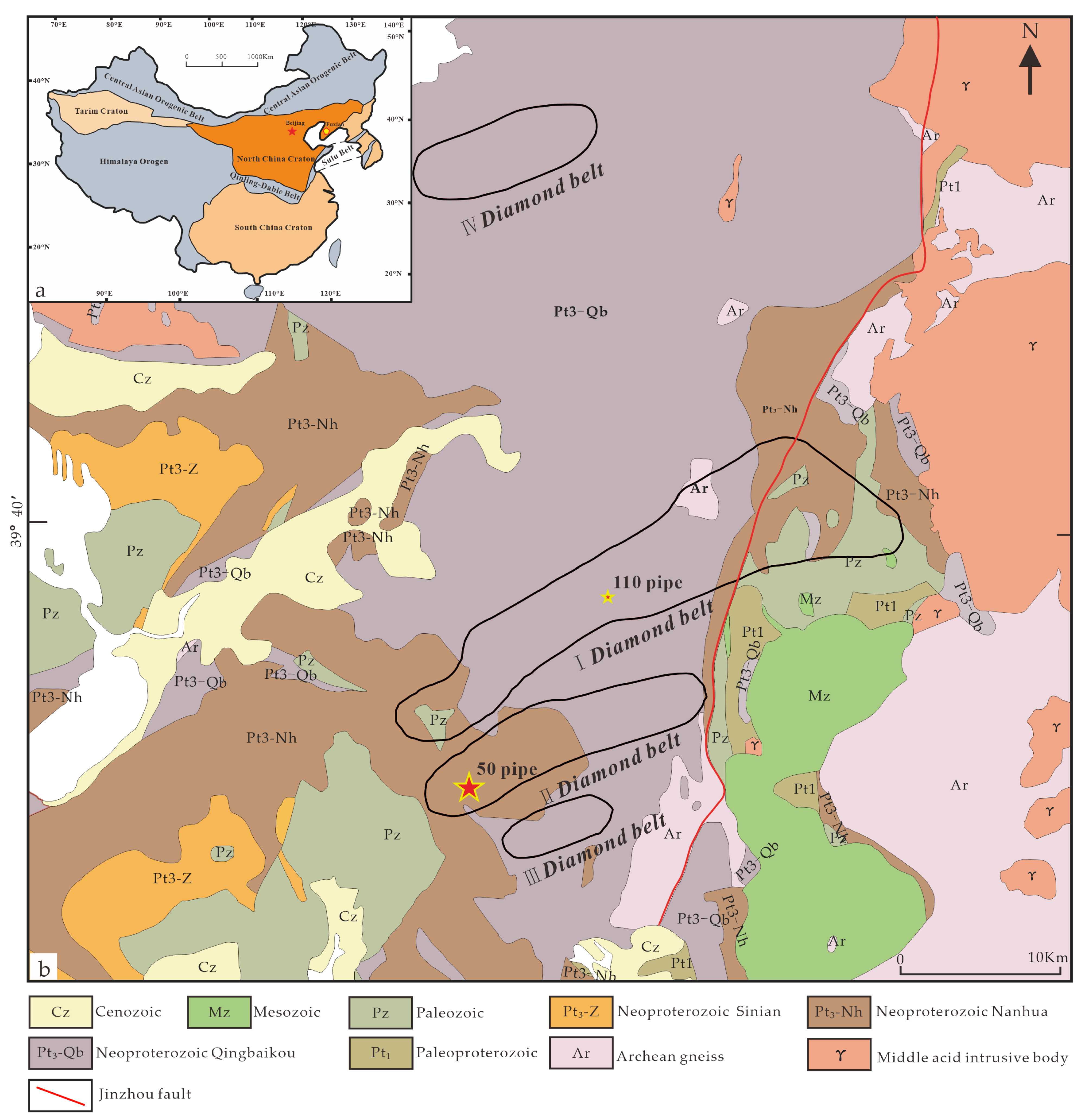
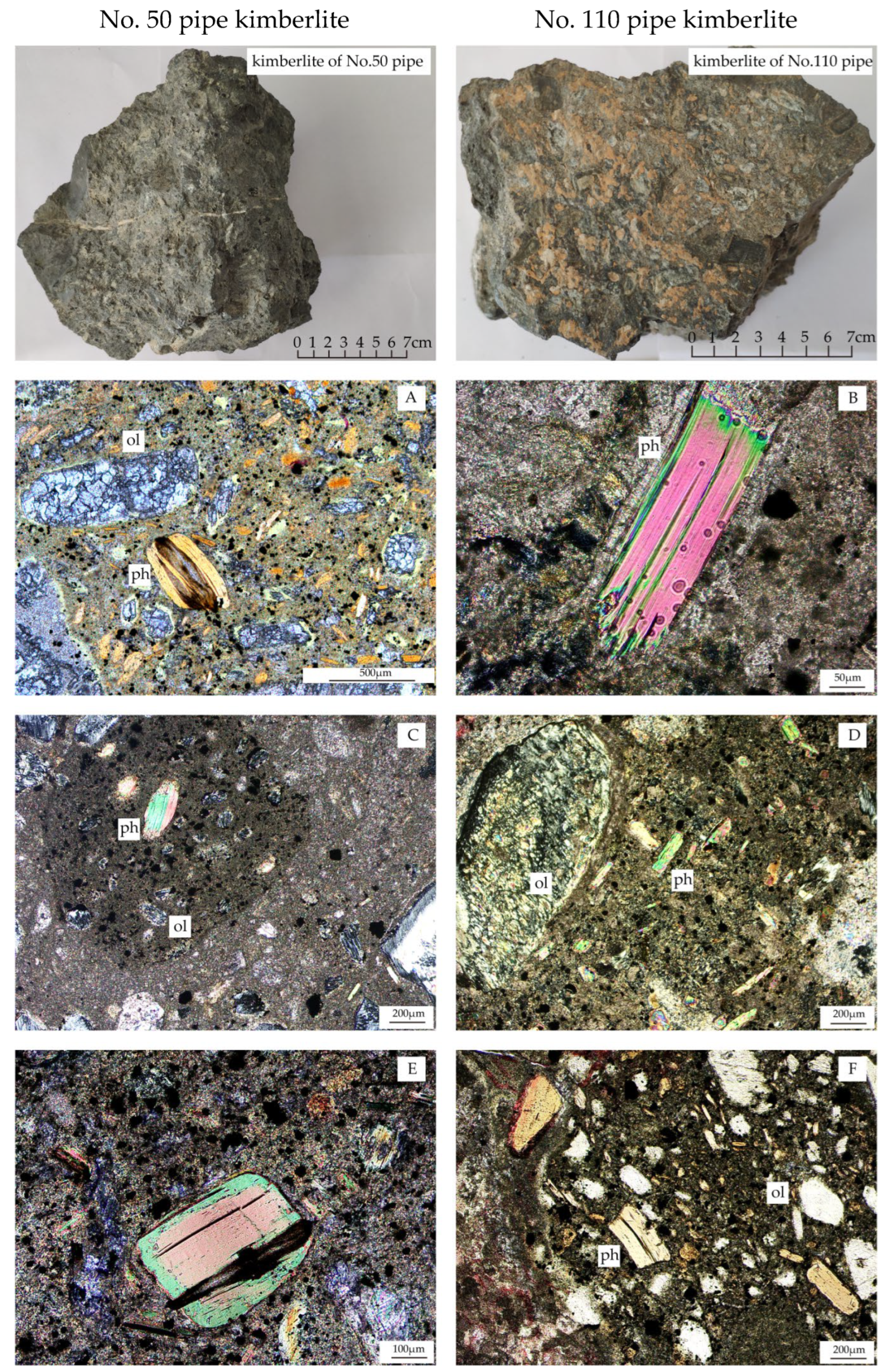
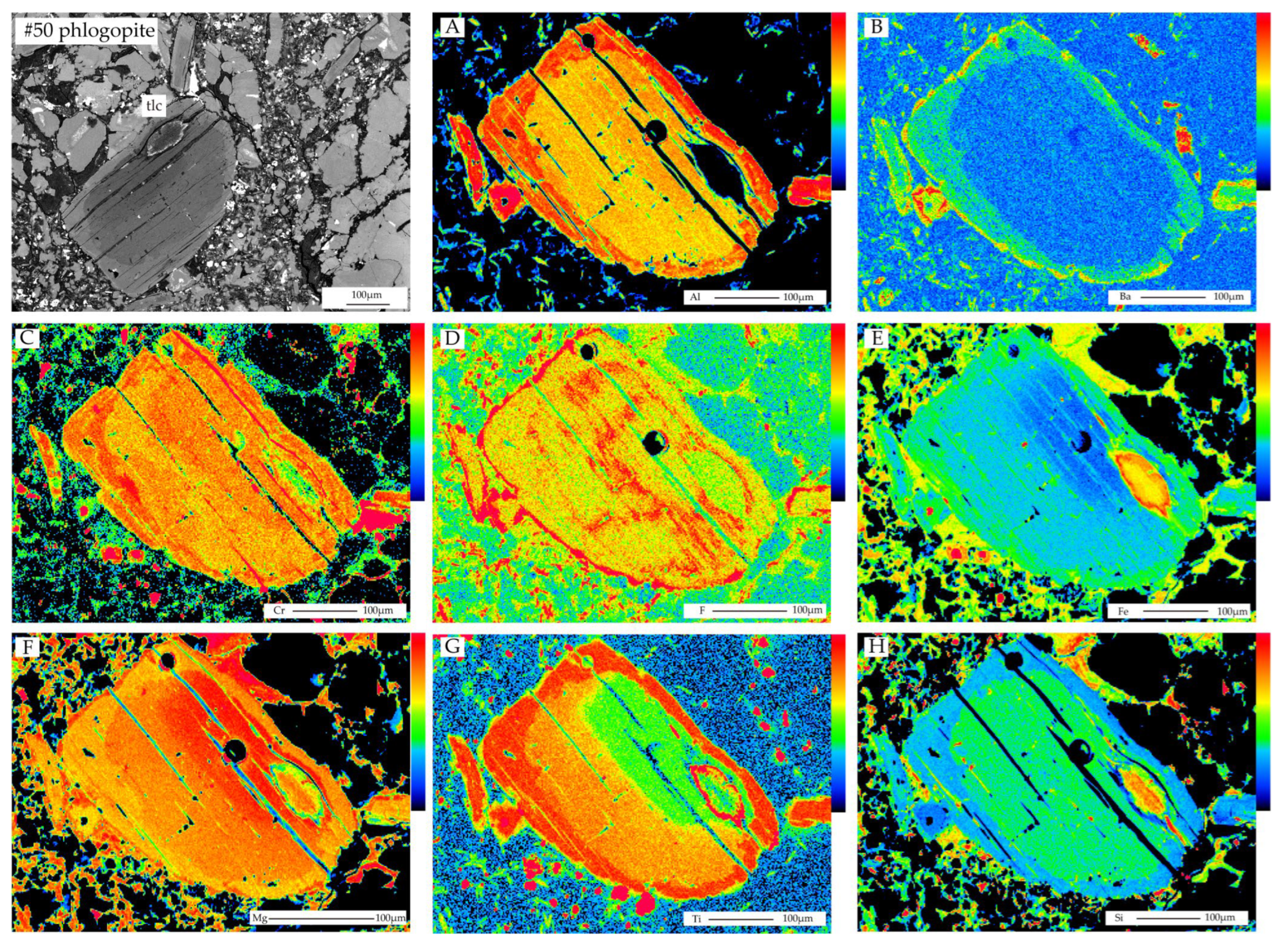
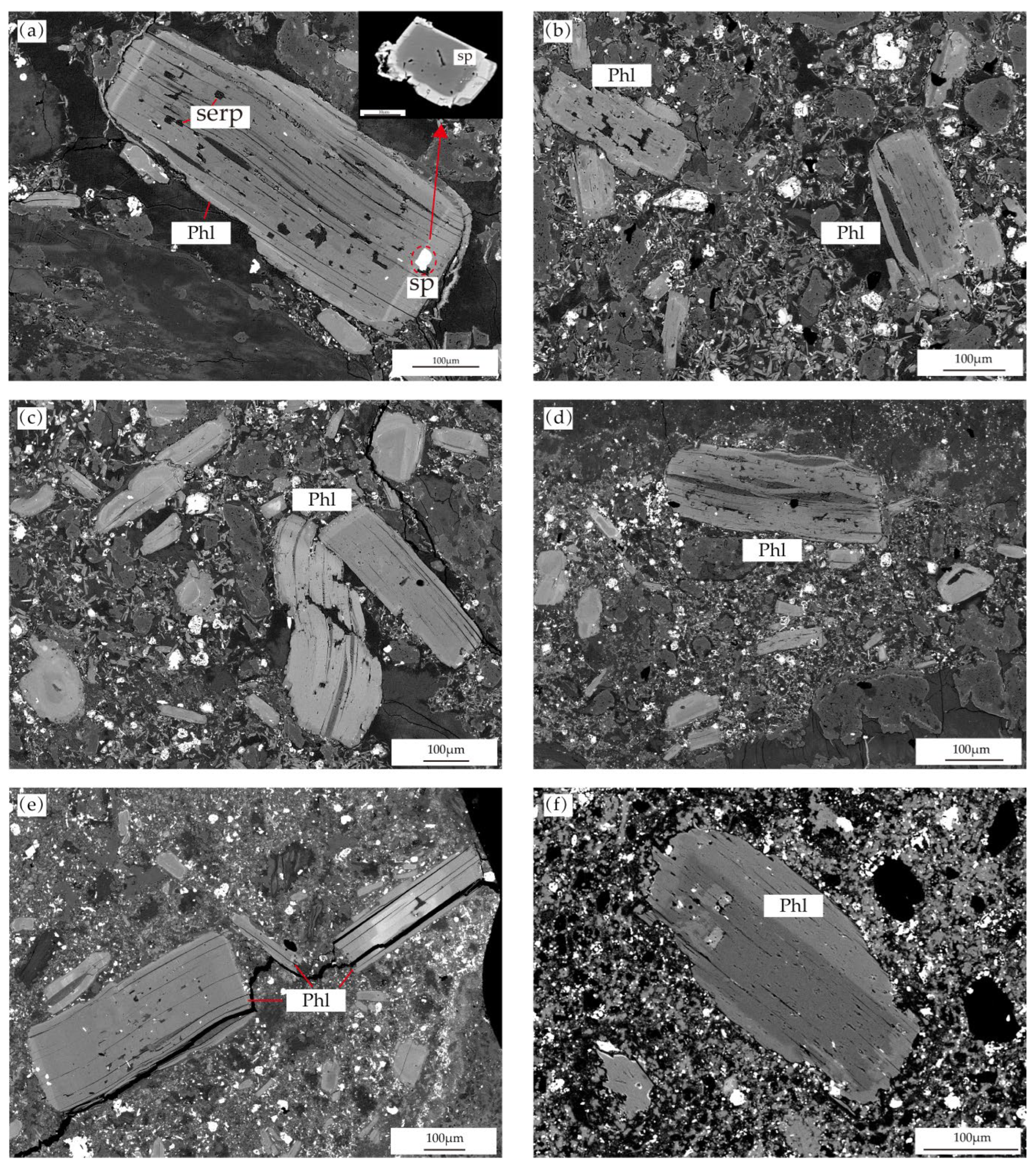


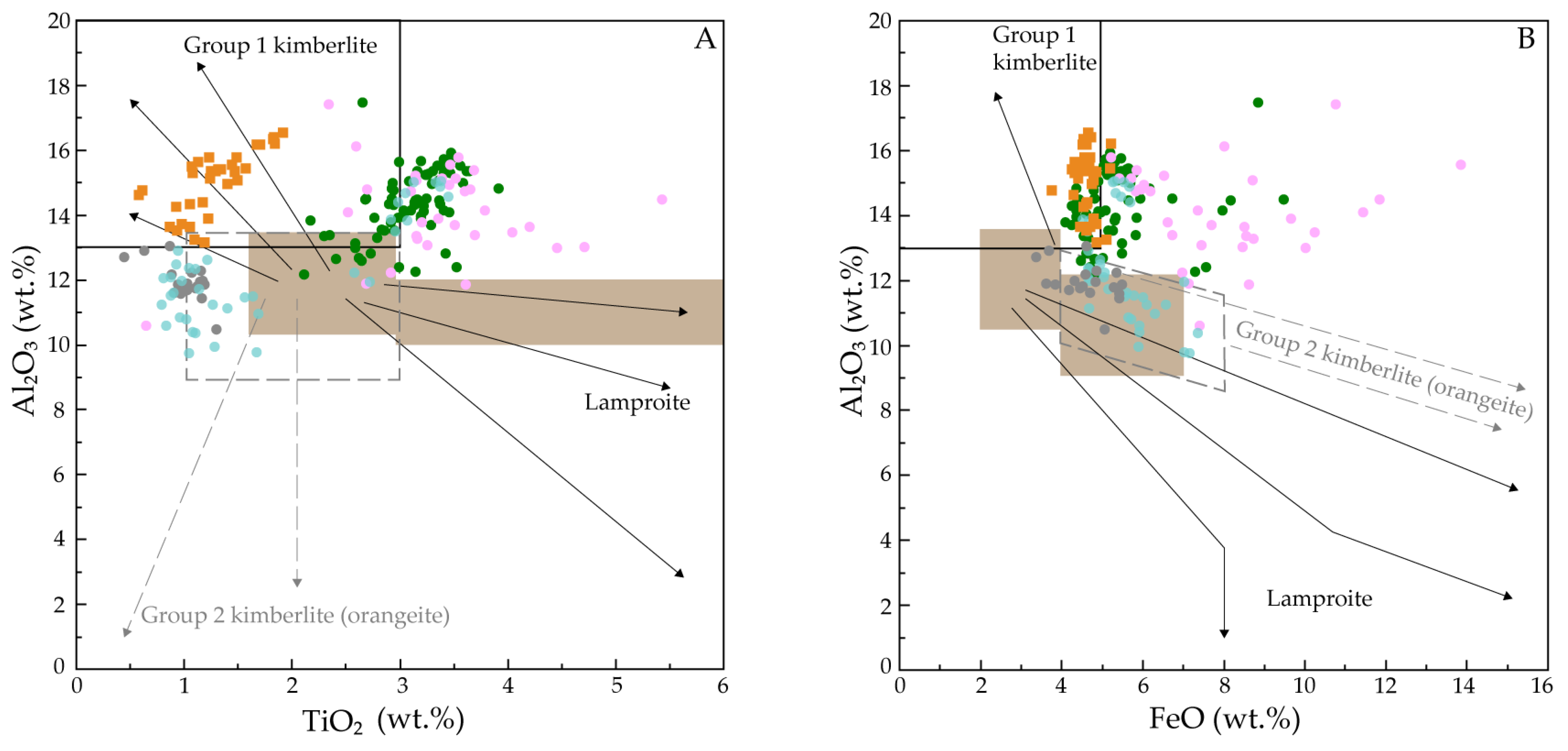
| Back-Scattered Electron Image | Cartoon Showing Zoning | Feature Description |
|---|---|---|
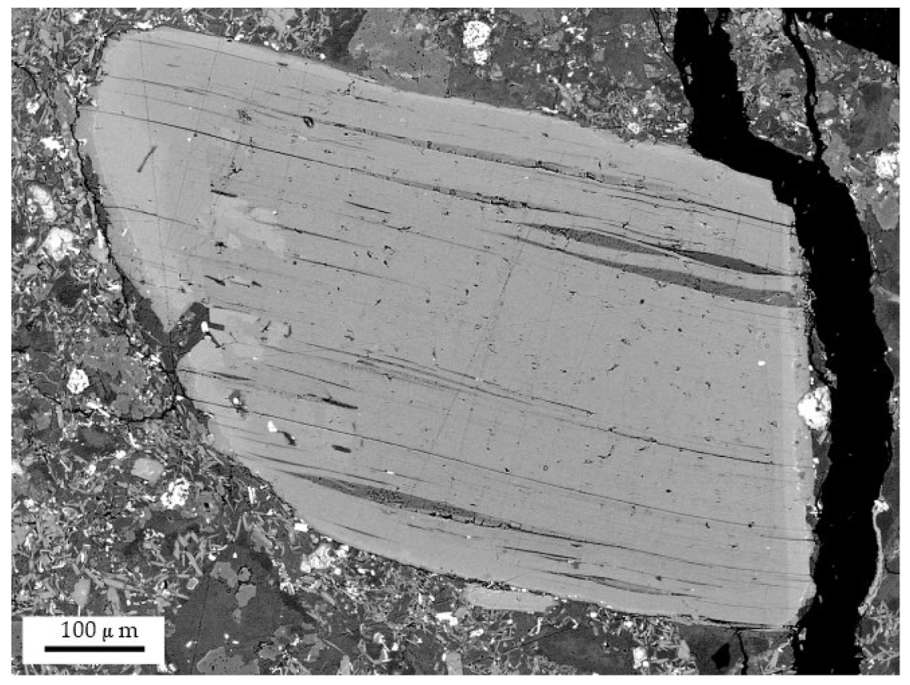 |  | High-Ti-Cr Core: anhedral(embayed texture), Cr2O3 = 0.2–1.6 wt.%, TiO2 = 2.2–3.5 wt.%, Mg# = 88.2 Low-Cr/Cr-Poor Rim: Cr2O3 < 0.2 wt.%, TiO2 = 2.5–5.4 wt.%, Mg# = 82.4 Rind I: Cr2O3 < 0.12 wt.%, TiO2 < 1.7 wt.%, Mg# = 88.4 |
 | 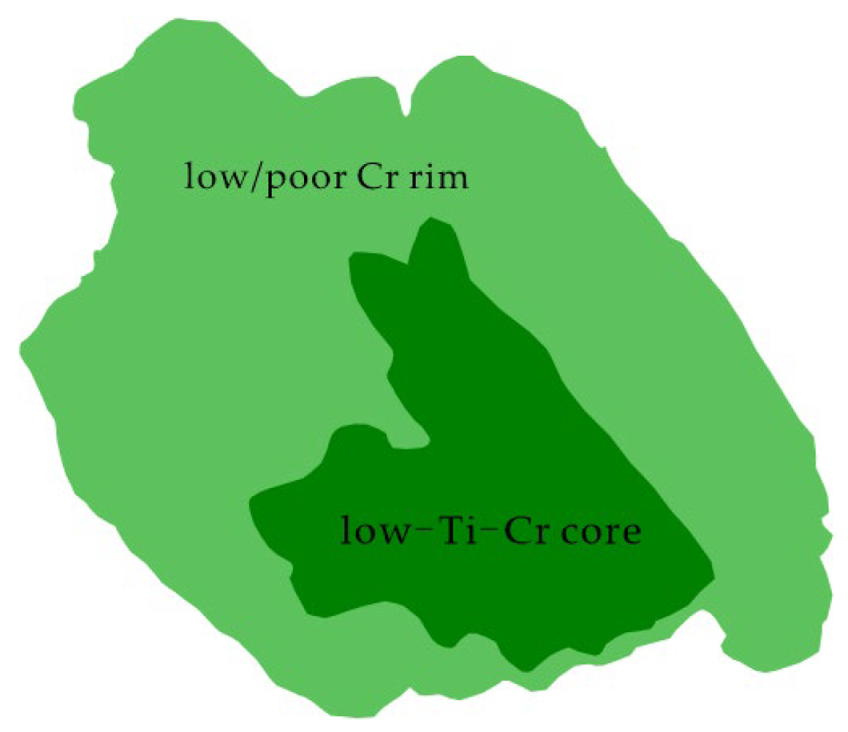 | Low-Ti-Cr Core: anhedral(embayed texture), Cr2O3 < 1.0 wt.%, TiO2 < 1.3 wt.%, Mg# = 90.6 Low-Cr/Cr-Poor Outer Rim: Cr2O3 < 0.2 wt.%, TiO2 = 2.5–5.4 wt.%, Mg# = 82.4 |
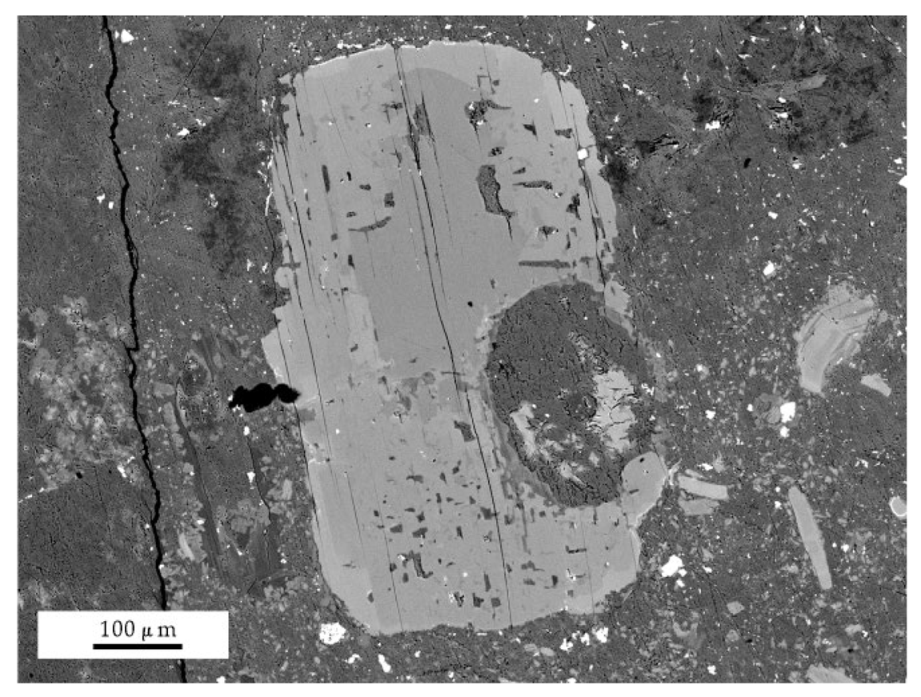 | 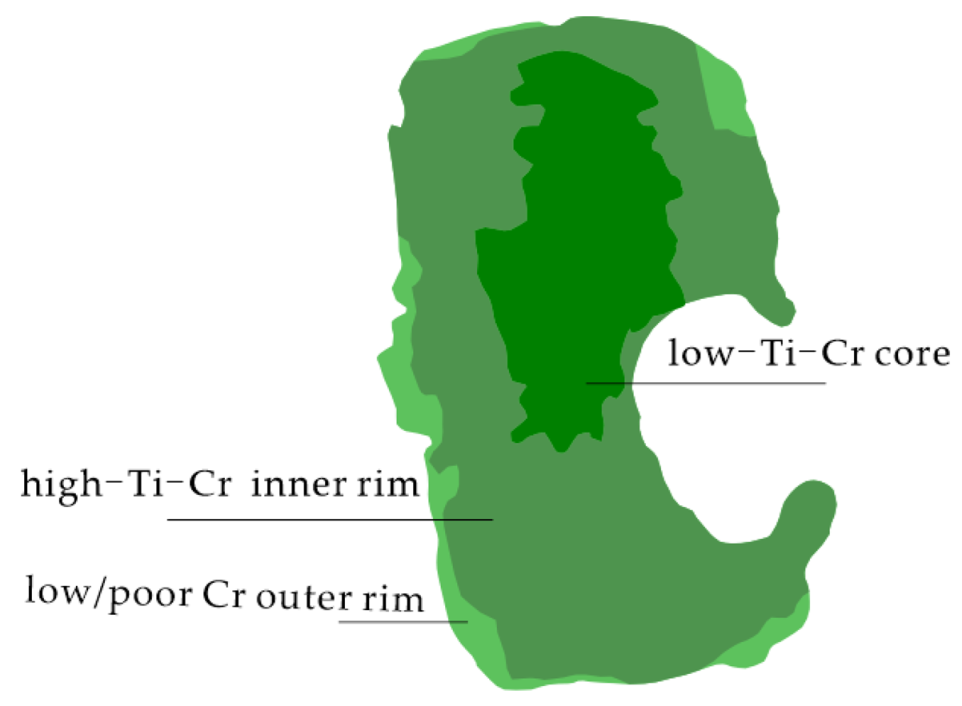 | Low-Ti-Cr Core: anhedral(embayed texture), Cr2O3 < 1.0 wt.%, TiO2 < 1.3 wt.%, Mg# = 90.6 High-Ti-Cr Inner Rim: Cr2O3 = 0.2–1.6 wt.%, TiO2 = 2.2–3.5 wt.%, Mg# = 88.2 Low-Cr/Cr-Poor Outer Rim: Cr2O3 < 0.2 wt.%, TiO2 = 2.5–5.4 wt.%, Mg# = 82.4 |
 | 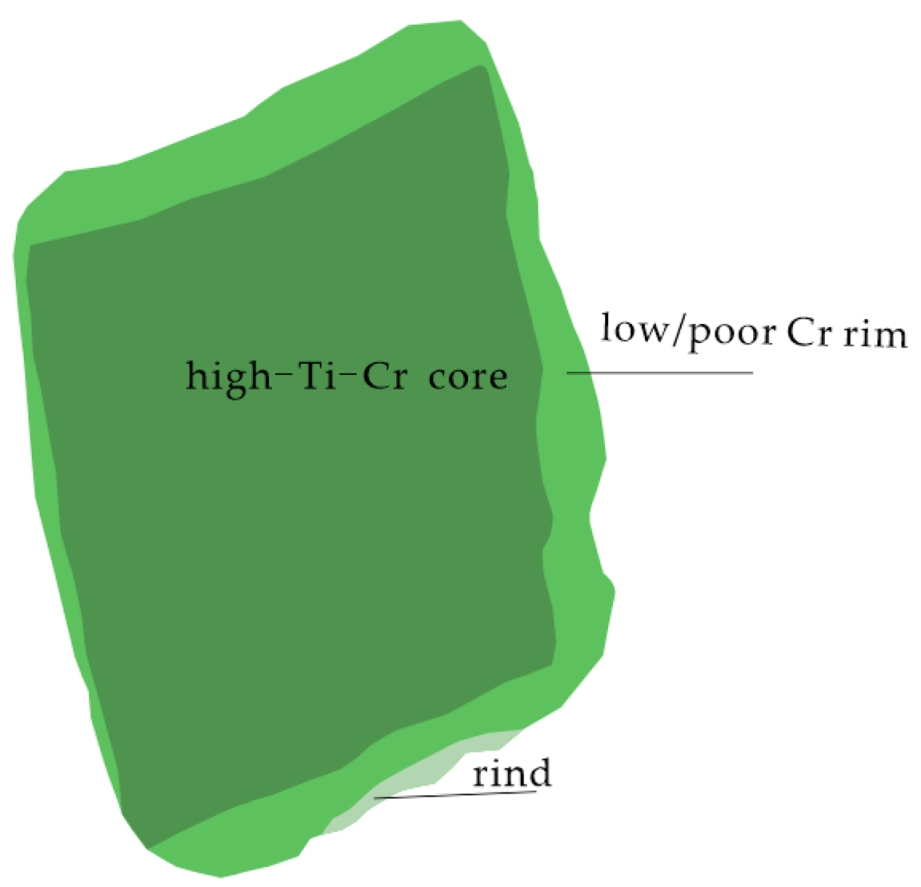 | High-Ti-Cr Core: euhedral, Cr2O3 = 0.2–1.6 wt.%, TiO2 = 2.2–3.5 wt.%; Mg# = 88.2 Low-Cr/Cr-Poor Rim: Cr2O3 < 0.2 wt.%, TiO2 = 2.5–5.4 wt.%, Mg# = 82.4 Rind II: Cr2O3 > 0.2 wt.%, TiO2 = 2.5–3.5 wt.%, Mg# = 88.6 |
| Sample | F | Na2O | SiO2 | Al2O3 | MgO | Cl | K2O | CaO | NiO | FeO | MnO | Cr2O3 | TiO2 | BaO | Total | Mg# |
|---|---|---|---|---|---|---|---|---|---|---|---|---|---|---|---|---|
| Low-Ti-Cr Cores | ||||||||||||||||
| #50-3 | 0.526 | 0.127 | 41.800 | 11.556 | 24.161 | 0.023 | 10.365 | 0.086 | 0.019 | 5.423 | 0.072 | 0.372 | 0.973 | 0.000 | 95.277 | 88.8 |
| #50-13 | 0.777 | 0.041 | 39.882 | 13.037 | 25.338 | 0.006 | 9.879 | 0.037 | 0.078 | 4.593 | 0.037 | 0.038 | 0.874 | 1.501 | 95.790 | 90.8 |
| #50-14 | 0.261 | 0.054 | 41.832 | 12.153 | 24.689 | 0.027 | 10.150 | 0.070 | 0.212 | 4.584 | 0.018 | 0.714 | 0.885 | 0.095 | 95.628 | 90.6 |
| #50-16 | 0.231 | 0.157 | 42.184 | 11.856 | 25.128 | 0.029 | 10.431 | 0.033 | 0.260 | 3.841 | 0.008 | 0.767 | 0.952 | 0.054 | 95.827 | 92.1 |
| #50-17 | 0.457 | 0.130 | 42.362 | 11.889 | 25.046 | 0.000 | 10.460 | 0.070 | 0.225 | 3.613 | 0.045 | 0.805 | 1.035 | 0.061 | 96.006 | 92.5 |
| #50-22 | 0.901 | 0.043 | 38.864 | 12.283 | 24.991 | 0.000 | 10.016 | 0.000 | 0.000 | 4.858 | 0.089 | 0.034 | 1.159 | 1.324 | 94.183 | 90.2 |
| #50-36 | 0.359 | 0.083 | 41.072 | 11.932 | 24.145 | 0.041 | 10.311 | 0.031 | 0.094 | 4.823 | 0.037 | 0.590 | 1.151 | 0.115 | 94.624 | 89.9 |
| #50-41 | 0.451 | 0.036 | 41.589 | 12.204 | 24.305 | 0.046 | 10.131 | 0.016 | 0.141 | 5.358 | 0.043 | 0.352 | 1.078 | 0.122 | 95.672 | 89.0 |
| #50-42 | 0.476 | 0.111 | 41.263 | 10.472 | 24.564 | 0.000 | 10.422 | 0.077 | 0.218 | 5.066 | 0.000 | 0.721 | 1.301 | 0.047 | 94.538 | 89.6 |
| #50-47 | 0.395 | 0.070 | 41.478 | 11.747 | 24.819 | 0.028 | 10.692 | 0.087 | 0.134 | 4.445 | 0.033 | 0.582 | 1.106 | 0.007 | 95.451 | 90.9 |
| #50-56 | 0.631 | 0.154 | 39.639 | 11.436 | 24.376 | 0.007 | 9.713 | 0.117 | 0.011 | 5.422 | 0.056 | 0.038 | 1.164 | 1.042 | 93.538 | 88.9 |
| #50-70 | 0.450 | 0.043 | 41.312 | 11.969 | 24.448 | 0.017 | 10.379 | 0.021 | 0.241 | 4.303 | 0.000 | 0.806 | 1.180 | 0.081 | 95.057 | 91.0 |
| #50-71 | 0.617 | 0.074 | 41.000 | 11.674 | 24.167 | 0.034 | 10.579 | 0.000 | 0.164 | 4.172 | 0.041 | 0.770 | 1.035 | 0.054 | 94.113 | 91.2 |
| #50-74 | 0.808 | 0.007 | 40.719 | 11.837 | 24.216 | 0.023 | 9.846 | 0.011 | 0.130 | 5.491 | 0.033 | 0.266 | 1.197 | 0.000 | 94.239 | 88.7 |
| #50-76 | 0.375 | 0.054 | 41.384 | 11.589 | 24.445 | 0.057 | 10.226 | 0.000 | 0.177 | 4.693 | 0.029 | 0.600 | 0.917 | 0.101 | 94.476 | 90.3 |
| #50-78 | 0.198 | 0.063 | 40.505 | 12.894 | 24.200 | 0.096 | 10.830 | 0.000 | 0.162 | 3.679 | 0.058 | 0.983 | 0.632 | 0.176 | 94.371 | 92.1 |
| #50-88 | 0.429 | 0.034 | 41.910 | 11.769 | 24.517 | 0.004 | 10.561 | 0.000 | 0.135 | 5.277 | 0.000 | 0.260 | 0.956 | 0.020 | 95.690 | 89.2 |
| #50-118 | 0.289 | 0.043 | 41.563 | 11.780 | 24.353 | 0.037 | 10.534 | 0.000 | 0.203 | 4.510 | 0.041 | 0.585 | 1.127 | 0.102 | 95.037 | 90.6 |
| #50-121 | 0.271 | 0.085 | 41.388 | 12.693 | 24.953 | 0.064 | 10.384 | 0.056 | 0.188 | 3.366 | 0.000 | 0.843 | 0.451 | 0.062 | 94.676 | 93.0 |
| High-Ti-Cr Cores/Inner Rims | ||||||||||||||||
| #50-1 | 0.242 | 0.035 | 38.921 | 14.068 | 22.693 | 0.000 | 10.482 | 0.000 | 0.021 | 4.964 | 0.039 | 1.105 | 3.460 | 0.306 | 96.234 | 89.1 |
| #50-5 | 0.096 | 0.119 | 41.360 | 12.624 | 22.760 | 0.026 | 10.439 | 0.013 | 0.172 | 4.799 | 0.000 | 1.400 | 2.411 | 0.020 | 96.193 | 89.4 |
| #50-8 | 0.253 | 0.101 | 38.825 | 14.292 | 23.057 | 0.000 | 10.317 | 0.026 | 0.144 | 4.442 | 0.008 | 1.186 | 2.944 | 0.454 | 95.942 | 90.2 |
| #50-15 | 0.245 | 0.041 | 38.634 | 14.753 | 23.121 | 0.000 | 10.078 | 0.019 | 0.028 | 4.787 | 0.058 | 1.268 | 2.946 | 0.345 | 96.220 | 89.6 |
| #50-24 | 0.145 | 0.050 | 37.471 | 15.036 | 22.706 | 0.000 | 10.059 | 0.008 | 0.072 | 4.903 | 0.056 | 0.868 | 3.087 | 0.723 | 95.123 | 89.2 |
| #50-27 | 0.205 | 0.048 | 37.825 | 13.938 | 22.918 | 0.000 | 10.481 | 0.000 | 0.081 | 4.345 | 0.016 | 1.189 | 3.023 | 0.624 | 94.607 | 90.4 |
| #50-28 | 0.206 | 0.087 | 39.264 | 13.126 | 22.871 | 0.000 | 10.597 | 0.021 | 0.028 | 5.484 | 0.041 | 0.846 | 2.593 | 0.310 | 95.387 | 88.1 |
| #50-35 | 0.251 | 0.034 | 38.325 | 14.263 | 22.982 | 0.006 | 10.206 | 0.008 | 0.105 | 4.232 | 0.070 | 1.246 | 3.222 | 0.438 | 95.281 | 90.6 |
| #50-37 | 0.158 | 0.193 | 40.611 | 12.675 | 23.004 | 0.032 | 10.238 | 0.039 | 0.086 | 5.016 | 0.029 | 0.769 | 2.626 | 0.229 | 95.631 | 89.1 |
| #50-43 | 0.308 | 0.041 | 37.940 | 14.291 | 22.297 | 0.001 | 10.295 | 0.032 | 0.075 | 4.307 | 0.056 | 1.256 | 3.139 | 0.558 | 94.466 | 90.2 |
| #50-46 | 0.258 | 0.047 | 38.437 | 13.774 | 23.202 | 0.000 | 10.46 | 0.010 | 0.135 | 4.076 | 0.000 | 0.901 | 2.921 | 0.330 | 94.442 | 91.0 |
| #50-48 | 0.194 | 0.016 | 37.860 | 14.963 | 22.978 | 0.000 | 9.812 | 0.018 | 0.075 | 4.791 | 0.100 | 1.015 | 3.301 | 0.639 | 95.680 | 89.5 |
| #50-49 | 0.175 | 0.050 | 37.880 | 14.809 | 22.542 | 0.000 | 10.419 | 0.031 | 0.113 | 4.355 | 0.046 | 1.177 | 2.927 | 0.612 | 95.062 | 90.2 |
| #50-54 | 0.104 | 0.077 | 37.561 | 14.986 | 22.459 | 0.005 | 9.814 | 0.096 | 0.077 | 4.833 | 0.037 | 0.975 | 2.933 | 0.611 | 94.523 | 89.2 |
| #50-57 | 0.389 | 0.079 | 40.907 | 12.161 | 23.363 | 0.015 | 9.952 | 0.019 | 0.180 | 4.814 | 0.042 | 0.767 | 2.112 | 0.061 | 94.694 | 89.6 |
| #50-58 | 0.280 | 0.050 | 37.734 | 14.024 | 22.567 | 0.007 | 9.716 | 0.016 | 0.099 | 4.606 | 0.012 | 1.254 | 3.041 | 0.429 | 93.715 | 89.7 |
| #50-61 | 0.139 | 0.020 | 39.555 | 12.808 | 21.98 | 0.024 | 10.362 | 0.034 | 0.183 | 4.594 | 0.021 | 1.658 | 2.735 | 0.08 | 94.129 | 89.5 |
| #50-68 | 0.096 | 0.212 | 38.627 | 13.836 | 22.304 | 0.004 | 10.111 | 0.000 | 0.139 | 5.294 | 0.029 | 1.456 | 2.173 | 0.295 | 94.535 | 88.2 |
| #50-69 | 0.278 | 0.044 | 38.036 | 13.505 | 22.599 | 0.000 | 9.678 | 0.000 | 0.074 | 5.260 | 0.064 | 1.256 | 2.955 | 0.420 | 94.052 | 88.5 |
| #50-72 | 0.179 | 0.016 | 37.783 | 14.324 | 22.940 | 0.000 | 10.257 | 0.000 | 0.124 | 4.577 | 0.046 | 1.237 | 2.900 | 0.585 | 94.893 | 89.9 |
| #50-77 | 0.161 | 0.039 | 37.701 | 14.321 | 22.908 | 0.007 | 10.422 | 0.023 | 0.066 | 4.572 | 0.099 | 1.176 | 3.376 | 0.337 | 95.138 | 89.9 |
| #50-79 | 0.221 | 0.007 | 38.131 | 14.463 | 22.599 | 0.009 | 10.242 | 0.000 | 0.051 | 4.417 | 0.043 | 1.148 | 3.166 | 0.628 | 95.030 | 90.1 |
| #50-81 | 0.276 | 0.027 | 37.940 | 13.970 | 22.686 | 0.000 | 10.397 | 0.006 | 0.058 | 4.859 | 0.037 | 1.131 | 3.201 | 0.479 | 94.951 | 89.3 |
| #50-85 | 0.265 | 0.080 | 39.156 | 14.132 | 22.704 | 0.002 | 10.478 | 0.000 | 0.115 | 5.074 | 0.006 | 1.120 | 3.102 | 0.332 | 96.454 | 88.9 |
| #50-90 | 0.295 | 0.094 | 40.354 | 12.397 | 22.845 | 0.010 | 10.463 | 0.019 | 0.142 | 4.702 | 0.033 | 0.808 | 2.998 | 0.163 | 95.197 | 89.6 |
| #50-91 | 0.277 | 0.057 | 38.776 | 13.549 | 23.285 | 0.026 | 10.229 | 0.000 | 0.119 | 4.630 | 0.043 | 0.814 | 2.835 | 0.394 | 94.911 | 90.0 |
| #50-99 | 0.170 | 0.032 | 40.553 | 13.349 | 22.737 | 0.032 | 10.739 | 0.000 | 0.186 | 4.546 | 0.000 | 1.745 | 2.305 | 0.014 | 96.329 | 89.9 |
| #50-102 | 0.260 | 0.044 | 38.942 | 14.505 | 23.232 | 0.000 | 10.278 | 0.000 | 0.013 | 4.803 | 0.094 | 1.201 | 3.252 | 0.435 | 96.95 | 89.6 |
| #50-112 | 0.127 | 0.115 | 40.144 | 12.575 | 22.469 | 0.015 | 10.500 | 0.000 | 0.199 | 4.463 | 0.033 | 1.378 | 2.645 | 0.000 | 94.607 | 90.0 |
| #50-117 | 0.216 | 0.092 | 37.801 | 14.136 | 22.340 | 0.000 | 10.387 | 0.000 | 0.104 | 4.355 | 0.000 | 1.300 | 3.035 | 0.470 | 94.145 | 90.1 |
| #50-119 | 0.284 | 0.032 | 38.946 | 12.979 | 22.436 | 0.026 | 10.385 | 0.010 | 0.248 | 4.617 | 0.047 | 1.640 | 2.592 | 0.088 | 94.204 | 89.6 |
| #50-120 | 0.313 | 0.066 | 39.395 | 13.883 | 23.185 | 0.000 | 10.12 | 0.021 | 0.066 | 4.792 | 0.039 | 1.066 | 3.196 | 0.292 | 96.302 | 89.6 |
| #50-122 | 0.277 | 0.099 | 39.174 | 13.500 | 22.912 | 0.000 | 10.316 | 0.094 | 0.103 | 5.154 | 0.074 | 0.833 | 2.863 | 0.578 | 95.860 | 88.8 |
| #50-124 | 0.255 | 0.126 | 38.39 | 14.376 | 22.553 | 0.000 | 10.197 | 0.044 | 0.061 | 4.512 | 0.000 | 0.902 | 3.139 | 0.483 | 94.931 | 89.9 |
| #50-75 | 0.231 | 0.002 | 36.792 | 15.229 | 22.418 | 0.000 | 10.116 | 0.024 | 0.128 | 5.131 | 0.052 | 0.603 | 3.255 | 1.271 | 95.155 | 88.6 |
| #50-59 | 0.130 | 0.045 | 37.913 | 14.118 | 22.711 | 0.022 | 10.230 | 0.024 | 0.073 | 4.888 | 0.013 | 0.608 | 3.224 | 0.550 | 94.489 | 89.2 |
| #50-31 | 0.272 | 0.075 | 38.997 | 13.38 | 22.714 | 0.000 | 10.231 | 0.003 | 0.053 | 5.823 | 0.041 | 0.660 | 2.354 | 0.296 | 94.784 | 87.4 |
| #50-86 | 0.241 | 0.090 | 37.992 | 13.901 | 22.394 | 0.000 | 10.471 | 0.008 | 0.068 | 5.849 | 0.052 | 0.592 | 2.771 | 0.365 | 94.693 | 87.2 |
| #50-2 | 0.293 | 0.090 | 36.790 | 15.268 | 22.014 | 0.018 | 10.006 | 0.105 | 0.079 | 5.619 | 0.052 | 0.214 | 3.264 | 1.204 | 94.889 | 87.5 |
| #50-4 | 0.086 | 0.012 | 36.847 | 15.396 | 22.416 | 0.000 | 10.043 | 0.023 | 0.026 | 5.588 | 0.017 | 0.259 | 3.419 | 1.285 | 95.381 | 87.7 |
| #50-9 | 0.235 | 0.044 | 37.517 | 15.358 | 22.612 | 0.000 | 10.104 | 0.044 | 0.059 | 5.234 | 0.039 | 0.343 | 3.645 | 1.272 | 96.407 | 88.5 |
| #50-12 | 0.231 | 0.035 | 37.419 | 15.501 | 22.138 | 0.012 | 10.14 | 0.047 | 0.096 | 5.158 | 0.085 | 0.334 | 3.348 | 1.367 | 95.811 | 88.4 |
| #50-20 | 0.325 | 0.052 | 39.039 | 13.695 | 22.654 | 0.018 | 10.272 | 0.000 | 0.000 | 4.242 | 0.045 | 0.255 | 3.290 | 0.427 | 94.173 | 90.5 |
| #50-25 | 0.236 | 0.039 | 36.691 | 15.447 | 22.574 | 0.000 | 10.205 | 0.026 | 0.000 | 5.261 | 0.035 | 0.297 | 3.443 | 1.356 | 95.511 | 88.4 |
| #50-26 | 0.196 | 0.037 | 36.665 | 15.754 | 22.457 | 0.006 | 10.017 | 0.06 | 0.085 | 5.454 | 0.099 | 0.348 | 3.485 | 1.167 | 95.746 | 88.0 |
| #50-33 | 0.226 | 0.055 | 36.500 | 15.709 | 22.509 | 0.000 | 10.253 | 0.019 | 0.028 | 5.081 | 0.079 | 0.354 | 3.408 | 1.298 | 95.424 | 88.8 |
| #50-34 | 0.227 | 0.035 | 37.037 | 14.801 | 22.425 | 0.016 | 10.069 | 0.045 | 0.086 | 6.164 | 0.095 | 0.224 | 3.915 | 1.45 | 96.489 | 86.6 |
| #50-38 | 0.202 | 0.062 | 36.792 | 15.9 | 22.788 | 0.006 | 10.141 | 0.014 | 0.021 | 5.197 | 0.004 | 0.282 | 3.476 | 1.463 | 96.262 | 88.7 |
| #50-44 | 0.092 | 0.016 | 36.562 | 15.506 | 22.159 | 0.014 | 10.182 | 0.058 | 0.049 | 5.032 | 0.039 | 0.318 | 3.562 | 1.497 | 95.044 | 88.7 |
| #50-50 | 0.190 | 0.032 | 36.67 | 15.357 | 22.215 | 0.000 | 9.928 | 0.000 | 0.066 | 5.199 | 0.091 | 0.416 | 3.313 | 1.255 | 94.652 | 88.4 |
| #50-51 | 0.298 | 0.041 | 38.809 | 13.293 | 23.208 | 0.022 | 10.486 | 0.024 | 0.060 | 4.648 | 0.046 | 0.383 | 2.792 | 0.344 | 94.324 | 89.9 |
| #50-52 | 0.344 | 0.059 | 36.371 | 15.658 | 22.187 | 0.002 | 9.722 | 0.011 | 0.045 | 5.211 | 0.056 | 0.384 | 3.203 | 1.033 | 94.141 | 88.4 |
| #50-60 | 0.154 | 0.057 | 36.563 | 15.054 | 22.061 | 0.010 | 9.930 | 0.067 | 0.114 | 5.38 | 0.038 | 0.296 | 3.364 | 1.378 | 94.399 | 88.0 |
| #50-64 | 0.211 | 0.116 | 38.727 | 13.916 | 22.483 | 0.002 | 10.243 | 0.000 | 0.049 | 5.335 | 0.031 | 0.402 | 2.984 | 0.409 | 94.819 | 88.3 |
| #50-65 | 0.158 | 0.062 | 36.501 | 15.347 | 22.167 | 0.000 | 10.101 | 0.000 | 0.052 | 5.249 | 0.046 | 0.330 | 3.165 | 1.238 | 94.349 | 88.3 |
| #50-73 | 0.108 | 0.042 | 36.049 | 15.101 | 22.333 | 0.007 | 10.029 | 0.002 | 0.132 | 5.502 | 0.105 | 0.336 | 3.132 | 1.266 | 94.097 | 87.9 |
| #50-80 | 0.207 | 0.163 | 39.886 | 12.807 | 22.11 | 0.036 | 10.332 | 0.000 | 0.134 | 5.495 | 0.014 | 0.494 | 3.424 | 0.223 | 95.230 | 87.8 |
| #50-82 | 0.136 | 0.048 | 36.558 | 14.449 | 22.434 | 0.002 | 9.892 | 0.039 | 0.094 | 5.649 | 0.050 | 0.393 | 3.372 | 1.085 | 94.144 | 87.6 |
| #50-93 | 0.192 | 0.032 | 37.173 | 15.292 | 22.243 | 0.007 | 10.098 | 0.013 | 0.006 | 5.786 | 0.049 | 0.219 | 3.411 | 1.225 | 95.663 | 87.3 |
| #50-103 | 0.104 | 0.147 | 38.639 | 14.493 | 21.738 | 0.000 | 10.296 | 0.000 | 0.021 | 6.731 | 0.092 | 0.377 | 2.927 | 0.435 | 95.956 | 85.2 |
| #50-104 | 0.212 | 0.019 | 36.961 | 15.355 | 22.954 | 0.009 | 10.039 | 0.000 | 0.108 | 5.461 | 0.057 | 0.242 | 3.444 | 1.236 | 96.006 | 88.2 |
| #50-105 | 0.187 | 0.042 | 37.140 | 15.333 | 22.615 | 0.000 | 9.971 | 0.026 | 0.108 | 5.452 | 0.074 | 0.301 | 3.622 | 1.244 | 96.036 | 88.1 |
| #50-110 | 0.096 | 0.042 | 36.977 | 15.434 | 22.388 | 0.000 | 10.251 | 0.000 | 0.036 | 5.649 | 0.068 | 0.217 | 3.417 | 1.408 | 95.943 | 87.6 |
| #50-111 | 0.132 | 0.085 | 36.481 | 14.991 | 21.522 | 0.007 | 9.969 | 0.006 | 0.144 | 5.688 | 0.071 | 0.203 | 3.589 | 1.151 | 93.981 | 87.1 |
| #50-113 | 0.148 | 0.028 | 36.312 | 15.293 | 22.158 | 0.000 | 10.226 | 0.002 | 0.042 | 5.099 | 0.076 | 0.317 | 3.468 | 1.249 | 94.356 | 88.6 |
| #50-114 | 0.248 | 0.210 | 38.493 | 14.496 | 21.986 | 0.000 | 10.116 | 0.013 | 0.040 | 5.945 | 0.020 | 0.221 | 2.691 | 0.483 | 94.858 | 86.8 |
| #50-115 | 0.237 | 0.037 | 36.371 | 15.23 | 22.333 | 0.000 | 10.202 | 0.042 | 0.081 | 5.349 | 0.062 | 0.332 | 3.244 | 1.392 | 94.812 | 88.2 |
| #50-116 | 0.302 | 0.110 | 39.535 | 12.236 | 21.827 | 0.002 | 10.140 | 0.024 | 0.076 | 7.298 | 0.117 | 0.486 | 3.149 | 0.407 | 95.582 | 84.2 |
| #50-125 | 0.277 | 0.095 | 36.736 | 15.617 | 22.269 | 0.000 | 9.761 | 0.065 | 0.049 | 5.307 | 0.070 | 0.328 | 2.997 | 1.284 | 94.738 | 88.2 |
| #50-7 | 0.236 | 0.250 | 38.21 | 14.464 | 18.881 | 0.017 | 10.011 | 0.016 | 0.036 | 9.473 | 0.118 | 0.659 | 2.684 | 0.276 | 95.228 | 78.0 |
| #50-97 | 0.138 | 0.074 | 36.199 | 17.45 | 19.233 | 0.004 | 9.888 | 0.000 | 0.089 | 8.852 | 0.097 | 0.224 | 2.661 | 0.891 | 95.741 | 79.5 |
| #50-18 | 0.281 | 0.056 | 39.128 | 12.375 | 22.086 | 0.000 | 10.019 | 0.040 | 0.117 | 7.565 | 0.048 | 0.365 | 3.533 | 0.371 | 95.866 | 83.9 |
| #50-100 | 0.256 | 0.264 | 37.926 | 14.443 | 20.394 | 0.000 | 10.356 | 0.000 | 0.051 | 8.168 | 0.080 | 0.476 | 3.145 | 0.338 | 95.789 | 81.7 |
| #50-101 | 0.074 | 0.125 | 38.133 | 14.145 | 20.346 | 0.013 | 10.189 | 0.000 | 0.070 | 7.956 | 0.041 | 0.409 | 3.411 | 0.264 | 95.142 | 82.0 |
| Low-Cr/Cr-Poor Outer Rims | ||||||||||||||||
| #50-19 | 0.166 | 0.019 | 37.756 | 13.054 | 22.438 | 0.009 | 10.057 | 0.006 | 0.055 | 7.457 | 0.041 | 0.197 | 3.257 | 0.438 | 94.878 | 84.3 |
| #50-87 | 0.164 | 0.030 | 36.634 | 15.766 | 22.422 | 0.000 | 10.103 | 0.039 | 0.057 | 5.211 | 0.047 | 0.196 | 3.546 | 1.542 | 95.688 | 88.5 |
| #50-6 | 0.279 | 0.051 | 37.108 | 15.115 | 22.433 | 0.000 | 9.894 | 0.000 | 0.051 | 5.704 | 0.054 | 0.140 | 3.519 | 1.414 | 95.645 | 87.5 |
| #50-10 | 0.830 | 0.081 | 40.667 | 10.578 | 25.349 | 0.000 | 9.250 | 0.115 | 0.057 | 7.398 | 0.029 | 0.009 | 0.654 | 0.502 | 95.170 | 85.9 |
| #50-11 | 1.092 | 0.074 | 37.828 | 14.457 | 15.961 | 0.064 | 10.091 | 0.000 | 0.000 | 11.838 | 0.039 | 0.007 | 5.431 | 0.689 | 97.097 | 70.6 |
| #50-21 | 0.224 | 0.042 | 36.976 | 14.786 | 22.631 | 0.000 | 10.150 | 0.016 | 0.057 | 5.915 | 0.052 | 0.004 | 2.700 | 1.418 | 94.877 | 87.2 |
| #50-23 | 0.240 | 0.089 | 38.110 | 14.088 | 18.308 | 0.012 | 10.025 | 0.016 | 0.036 | 11.445 | 0.106 | 0.027 | 2.524 | 0.381 | 95.303 | 74.0 |
| #50-29 | 0.254 | 0.059 | 38.029 | 13.014 | 19.828 | 0.011 | 10.328 | 0.000 | 0.041 | 8.464 | 0.094 | 0.000 | 4.713 | 0.442 | 95.168 | 80.7 |
| #50-30 | 0.255 | 0.028 | 38.679 | 13.621 | 20.726 | 0.012 | 9.807 | 0.013 | 0.000 | 8.502 | 0.093 | 0.009 | 4.204 | 0.349 | 96.188 | 81.3 |
| #50-32 | 0.300 | 0.019 | 39.447 | 11.834 | 21.175 | 0.000 | 10.105 | 0.008 | 0.034 | 8.620 | 0.075 | 0.029 | 3.611 | 0.101 | 95.232 | 81.4 |
| #50-39 | 0.203 | 0.174 | 37.362 | 13.444 | 19.205 | 0.010 | 9.897 | 0.029 | 0.101 | 10.243 | 0.094 | 0.000 | 4.048 | 0.573 | 95.296 | 77.0 |
| #50-40 | 0.246 | 0.050 | 36.788 | 15.114 | 21.996 | 0.000 | 9.818 | 0.000 | 0.049 | 5.423 | 0.035 | 0.110 | 3.395 | 1.504 | 94.424 | 87.8 |
| #50-45 | 0.263 | 0.142 | 37.727 | 14.129 | 20.482 | 0.000 | 9.860 | 0.000 | 0.000 | 7.360 | 0.121 | 0.062 | 3.788 | 0.59 | 94.413 | 83.2 |
| #50-53 | 0.112 | 0.081 | 35.589 | 17.416 | 17.890 | 0.018 | 9.791 | 0.051 | 0.037 | 10.755 | 0.098 | 0.035 | 2.345 | 0.672 | 94.839 | 74.8 |
| #50-55 | 0.218 | 0.117 | 36.751 | 14.769 | 21.804 | 0.000 | 9.527 | 0.115 | 0.009 | 5.958 | 0.121 | 0.085 | 3.658 | 1.338 | 94.378 | 86.7 |
| #50-62 | 0.193 | 0.058 | 36.521 | 14.729 | 21.782 | 0.027 | 9.748 | 0.047 | 0.089 | 5.823 | 0.058 | 0.036 | 3.106 | 1.428 | 93.558 | 87.0 |
| #50-63 | 0.226 | 0.197 | 36.689 | 16.109 | 19.393 | 0.000 | 10.091 | 0.003 | 0.045 | 8.006 | 0.025 | 0.132 | 2.601 | 0.493 | 93.915 | 81.2 |
| #50-66 | 0.183 | 0.126 | 38.620 | 12.223 | 22.296 | 0.000 | 10.318 | 0.047 | 0.066 | 6.963 | 0.045 | 0.079 | 2.923 | 0.576 | 94.388 | 85.1 |
| #50-67 | 0.133 | 0.072 | 37.201 | 12.986 | 18.633 | 0.022 | 10.002 | 0.058 | 0.015 | 10.029 | 0.136 | 0.033 | 4.464 | 0.504 | 94.227 | 76.8 |
| #50-83 | 0.217 | 0.235 | 38.399 | 13.332 | 20.645 | 0.004 | 10.218 | 0.000 | 0.000 | 8.548 | 0.066 | 0.127 | 3.155 | 0.337 | 95.191 | 81.1 |
| #50-84 | 0.222 | 0.228 | 38.936 | 13.271 | 20.572 | 0.004 | 10.133 | 0.027 | 0.008 | 8.723 | 0.070 | 0.147 | 3.165 | 0.357 | 95.769 | 80.8 |
| #50-89 | 0.288 | 0.000 | 38.239 | 13.755 | 22.741 | 0.007 | 10.104 | 0.000 | 0.000 | 6.614 | 0.010 | 0.173 | 3.204 | 0.886 | 95.898 | 86.0 |
| #50-92 | 0.377 | 0.074 | 37.228 | 14.914 | 22.367 | 0.000 | 9.817 | 0.006 | 0.036 | 6.034 | 0.062 | 0.000 | 3.460 | 1.353 | 95.569 | 86.9 |
| #50-94 | 0.179 | 0.072 | 36.900 | 15.370 | 22.278 | 0.007 | 9.886 | 0.010 | 0.006 | 5.849 | 0.008 | 0.084 | 3.690 | 1.317 | 95.579 | 87.2 |
| #50-95 | 0.157 | 0.155 | 37.133 | 13.892 | 20.080 | 0.012 | 9.902 | 0.000 | 0.000 | 9.666 | 0.083 | 0.040 | 3.361 | 0.593 | 95.005 | 78.7 |
| #50-96 | 0.322 | 0.194 | 35.327 | 15.541 | 16.218 | 0.018 | 9.395 | 0.000 | 0.008 | 13.862 | 0.141 | 0.020 | 3.468 | 1.001 | 95.375 | 67.6 |
| #50-98 | 0.279 | 0.014 | 36.395 | 15.192 | 22.321 | 0.000 | 9.500 | 0.000 | 0.089 | 6.516 | 0.070 | 0.054 | 3.144 | 1.435 | 94.892 | 85.9 |
| #50-106 | 0.216 | 0.079 | 38.722 | 13.368 | 22.400 | 0.005 | 10.312 | 0.016 | 0.023 | 6.730 | 0.025 | 0.029 | 3.697 | 0.483 | 96.013 | 85.6 |
| #50-107 | 0.133 | 0.090 | 37.117 | 15.076 | 20.077 | 0.011 | 10.301 | 0.000 | 0.000 | 8.712 | 0.035 | 0.022 | 3.160 | 0.759 | 95.435 | 80.4 |
| #50-108 | 0.240 | 0.153 | 38.297 | 13.684 | 21.577 | 0.006 | 10.176 | 0.019 | 0.072 | 7.691 | 0.082 | 0.027 | 3.515 | 0.468 | 95.905 | 83.3 |
| #50-109 | 0.357 | 0.049 | 39.266 | 11.884 | 23.156 | 0.000 | 10.294 | 0.024 | 0.000 | 7.139 | 0.066 | 0.016 | 2.694 | 0.293 | 95.088 | 85.3 |
| #50-123 | 0.196 | 0.042 | 36.337 | 14.712 | 22.056 | 0.010 | 10.044 | 0.065 | 0.036 | 6.184 | 0.053 | 0.068 | 3.605 | 1.179 | 94.502 | 86.4 |
| Rind I (low-Ti-Cr) | ||||||||||||||||
| #50-1 | 0.784 | 0.032 | 40.295 | 9.773 | 24.606 | 0.006 | 10.158 | 0.091 | 0.073 | 7.018 | 0.066 | 0.011 | 1.677 | 0.507 | 94.778 | 86.2 |
| #50-2 | 0.949 | 0.054 | 40.606 | 11.962 | 24.635 | 0.000 | 10.084 | 0.139 | 0.044 | 4.691 | 0.033 | 0.025 | 0.982 | 1.125 | 94.971 | 90.4 |
| #50-4 | 0.886 | 0.057 | 40.185 | 12.465 | 25.626 | 0.000 | 10.079 | 0.099 | 0.051 | 4.951 | 0.078 | 0.049 | 0.931 | 0.792 | 95.875 | 90.2 |
| #50-5 | 0.946 | 0.066 | 39.887 | 12.056 | 25.518 | 0.002 | 10.537 | 0.024 | 0.013 | 4.650 | 0.015 | 0.064 | 0.813 | 1.118 | 95.312 | 90.7 |
| #50-6 | 0.913 | 0.048 | 39.722 | 12.060 | 25.305 | 0.000 | 10.474 | 0.038 | 0.085 | 5.028 | 0.057 | 0.000 | 0.882 | 1.035 | 95.281 | 90.0 |
| #50-7 | 0.848 | 0.040 | 40.522 | 12.618 | 24.023 | 0.000 | 10.274 | 0.047 | 0.066 | 4.940 | 0.057 | 0.008 | 1.220 | 1.374 | 95.682 | 89.7 |
| #50-8 | 0.675 | 0.031 | 39.477 | 11.230 | 25.938 | 0.013 | 10.088 | 0.111 | 0.035 | 6.562 | 0.032 | 0.032 | 1.269 | 0.859 | 96.092 | 87.6 |
| #50-9 | 0.878 | 0.054 | 41.436 | 11.523 | 25.517 | 0.001 | 10.119 | 0.041 | 0.013 | 5.768 | 0.052 | 0.004 | 0.882 | 0.621 | 96.566 | 88.8 |
| #50-10 | 1.068 | 0.010 | 41.629 | 10.573 | 25.033 | 0.003 | 10.319 | 0.039 | 0.126 | 5.903 | 0.084 | 0.015 | 0.836 | 0.555 | 95.744 | 88.3 |
| #50-11 | 0.933 | 0.028 | 41.456 | 10.821 | 23.894 | 0.012 | 10.136 | 0.072 | 0.058 | 5.649 | 0.028 | 0.045 | 0.964 | 0.506 | 94.204 | 88.3 |
| #50-12 | 1.062 | 0.046 | 40.451 | 11.462 | 23.428 | 0.006 | 9.661 | 0.139 | 0.070 | 6.008 | 0.080 | 0.077 | 1.564 | 0.985 | 94.625 | 87.4 |
| #50-13 | 0.844 | 0.046 | 40.396 | 11.593 | 25.173 | 0.000 | 10.147 | 0.189 | 0.036 | 5.586 | 0.041 | 0.066 | 0.901 | 0.728 | 95.432 | 88.9 |
| #50-14 | 1.002 | 0.028 | 40.940 | 10.776 | 24.149 | 0.005 | 10.230 | 0.054 | 0.028 | 5.707 | 0.055 | 0.036 | 1.025 | 0.639 | 94.255 | 88.3 |
| #50-15 | 0.849 | 0.033 | 40.310 | 10.343 | 24.426 | 0.000 | 9.298 | 0.093 | 0.100 | 7.361 | 0.052 | 0.067 | 1.105 | 0.624 | 94.355 | 85.6 |
| #50-18 | 0.997 | 0.034 | 40.860 | 10.377 | 24.350 | 0.000 | 10.099 | 0.161 | 0.065 | 5.911 | 0.045 | 0.089 | 1.079 | 0.675 | 94.364 | 88.0 |
| #50-20 | 0.921 | 0.030 | 40.949 | 9.743 | 23.807 | 0.008 | 10.020 | 0.205 | 0.079 | 7.143 | 0.071 | 0.037 | 1.049 | 0.457 | 94.220 | 85.6 |
| #50-24 | 0.951 | 0.036 | 41.331 | 11.233 | 24.849 | 0.000 | 9.524 | 0.142 | 0.063 | 6.086 | 0.037 | 0.053 | 0.797 | 0.779 | 95.506 | 87.9 |
| #50-29 | 1.188 | 0.025 | 40.708 | 11.486 | 24.486 | 0.000 | 10.429 | 0.044 | 0.054 | 5.562 | 0.044 | 0.000 | 1.640 | 0.892 | 96.060 | 88.7 |
| #50-30 | 1.401 | 0.024 | 41.849 | 9.936 | 23.243 | 0.000 | 10.370 | 0.820 | 0.031 | 5.882 | 0.110 | 0.108 | 1.284 | 0.445 | 94.920 | 87.6 |
| #50-31 | 1.331 | 0.014 | 41.861 | 11.107 | 24.645 | 0.002 | 10.309 | 0.054 | 0.032 | 4.663 | 0.043 | 0.173 | 1.406 | 1.113 | 96.192 | 90.4 |
| #50-36 | 0.892 | 0.070 | 39.421 | 12.885 | 25.606 | 0.003 | 9.969 | 0.238 | 0.084 | 4.659 | 0.060 | 0.041 | 0.948 | 1.741 | 96.242 | 90.8 |
| #50-37 | 1.139 | 0.022 | 40.798 | 12.335 | 24.981 | 0.006 | 10.280 | 0.102 | 0.029 | 4.672 | 0.071 | 0.004 | 1.113 | 1.529 | 96.601 | 90.5 |
| #50-38 | 1.012 | 0.040 | 40.280 | 12.368 | 24.540 | 0.001 | 10.060 | 0.096 | 0.081 | 4.651 | 0.037 | 0.000 | 1.049 | 1.803 | 95.626 | 90.4 |
| #50-27 | 0.355 | 0.057 | 37.656 | 14.390 | 22.117 | 0.009 | 10.370 | 0.036 | 0.021 | 5.691 | 0.015 | 0.027 | 2.983 | 1.219 | 94.793 | 87.4 |
| #50-28 | 0.446 | 0.136 | 39.567 | 11.921 | 22.253 | 0.001 | 10.395 | 0.048 | 0.048 | 7.012 | 0.035 | 0.102 | 2.726 | 0.535 | 95.052 | 85.0 |
| #50-40 | 0.287 | 0.073 | 37.050 | 15.001 | 22.392 | 0.009 | 10.243 | 0.131 | 0.057 | 5.528 | 0.048 | 0.117 | 3.334 | 1.171 | 95.318 | 87.8 |
| #50-32 | 1.088 | 0.046 | 40.315 | 10.943 | 24.097 | 0.000 | 10.363 | 0.030 | 10.363 | 6.301 | 0.072 | 0.012 | 1.690 | 0.886 | 95.423 | 87.2 |
| Rind II (high-Ti-Cr) | ||||||||||||||||
| #50-17 | 0.426 | 0.101 | 40.133 | 12.201 | 22.078 | 0.015 | 10.395 | 0.189 | 0.049 | 5.051 | 0.036 | 0.938 | 2.579 | 0.254 | 94.279 | 88.6 |
| #50-21 | 0.399 | 0.049 | 39.245 | 13.493 | 22.614 | 0.007 | 10.745 | 0.034 | 0.049 | 4.626 | 0.011 | 0.851 | 2.958 | 0.456 | 95.365 | 89.7 |
| #50-22 | 0.400 | 0.055 | 39.222 | 13.824 | 22.332 | 0.000 | 10.503 | 0.063 | 0.065 | 4.677 | 0.010 | 0.927 | 3.068 | 0.528 | 95.505 | 89.5 |
| #50-39 | 0.315 | 0.095 | 38.958 | 13.853 | 22.781 | 0.000 | 10.473 | 0.092 | 0.087 | 4.515 | 0.022 | 1.182 | 2.919 | 0.432 | 95.593 | 90.0 |
| #50-25 | 0.378 | 0.076 | 37.018 | 14.569 | 21.765 | 0.001 | 9.982 | 0.094 | 0.040 | 5.451 | 0.058 | 0.211 | 3.451 | 1.413 | 94.385 | 87.7 |
| #50-19 | 0.471 | 0.046 | 37.520 | 14.876 | 22.135 | 0.000 | 10.060 | 0.067 | 0.030 | 5.663 | 0.060 | 0.238 | 3.379 | 1.291 | 95.648 | 87.5 |
| #50-35 | 0.277 | 0.054 | 37.293 | 15.033 | 22.076 | 0.002 | 10.516 | 0.010 | 0.033 | 5.295 | 0.067 | 0.371 | 3.386 | 1.221 | 95.516 | 88.2 |
| #50-33 | 0.377 | 0.053 | 37.690 | 14.666 | 21.871 | 0.009 | 10.379 | 0.000 | 0.068 | 5.329 | 0.026 | 0.206 | 3.054 | 1.185 | 94.752 | 88.0 |
| #50-34 | 0.333 | 0.055 | 37.865 | 15.016 | 21.555 | 0.003 | 10.370 | 0.045 | 0.041 | 5.253 | 0.045 | 0.240 | 3.134 | 1.485 | 95.298 | 88.0 |
| #50-16 | 0.616 | 0.074 | 42.132 | 11.718 | 23.454 | 0.055 | 10.440 | 0.141 | 0.130 | 5.145 | 0.037 | 0.327 | 1.141 | 0.008 | 95.184 | 89.1 |
| Sample | F | Na2O | SiO2 | Al2O3 | MgO | Cl | K2O | CaO | NiO | FeO | MnO | Cr2O3 | TiO2 | BaO | Total | Mg# |
|---|---|---|---|---|---|---|---|---|---|---|---|---|---|---|---|---|
| #110-1 | 1.225 | 0.018 | 38.278 | 13.886 | 23.869 | 0.008 | 9.936 | 0.011 | 0.026 | 4.795 | 0.060 | 0.056 | 1.229 | 2.509 | 95.391 | 89.9 |
| #110-2 | 1.083 | 0.109 | 35.982 | 15.778 | 23.237 | 0.007 | 9.115 | 0.015 | 0.042 | 4.569 | 0.091 | 0.057 | 1.488 | 5.188 | 96.315 | 90.1 |
| #110-3 | 1.149 | 0.054 | 34.410 | 16.381 | 22.856 | 0.000 | 8.395 | 0.061 | 0.069 | 4.717 | 0.004 | 0.025 | 1.835 | 6.968 | 96.440 | 89.6 |
| #110-4 | 0.962 | 0.044 | 36.332 | 15.638 | 23.407 | 0.000 | 9.445 | 0.035 | 0.000 | 4.304 | 0.045 | 0.031 | 1.132 | 4.394 | 95.363 | 90.7 |
| #110-5 | 1.132 | 0.025 | 38.738 | 13.241 | 24.318 | 0.000 | 10.444 | 0.031 | 0.029 | 5.090 | 0.027 | 0.015 | 1.103 | 1.597 | 95.318 | 89.5 |
| #110-6 | 1.079 | 0.030 | 34.603 | 16.175 | 23.069 | 0.000 | 8.389 | 0.038 | 0.000 | 4.608 | 0.074 | 0.098 | 1.712 | 6.819 | 96.256 | 89.9 |
| #110-7 | 0.943 | 0.015 | 35.986 | 15.550 | 23.175 | 0.005 | 9.054 | 0.011 | 0.000 | 4.676 | 0.076 | 0.080 | 1.448 | 5.228 | 95.863 | 89.8 |
| #110-8 | 1.087 | 0.001 | 39.158 | 13.143 | 23.943 | 0.000 | 10.282 | 0.022 | 0.047 | 4.844 | 0.073 | 0.056 | 1.190 | 1.579 | 94.967 | 89.8 |
| #110-9 | 1.211 | 0.092 | 34.441 | 16.152 | 23.280 | 0.003 | 8.484 | 0.036 | 0.002 | 4.519 | 0.069 | 0.128 | 1.673 | 6.694 | 96.273 | 90.2 |
| #110-10 | 1.040 | 0.047 | 36.715 | 15.316 | 23.334 | 0.000 | 9.092 | 0.119 | 0.000 | 4.844 | 0.056 | 0.017 | 1.476 | 4.482 | 96.100 | 89.6 |
| #110-11 | 0.948 | 0.038 | 39.218 | 13.516 | 24.103 | 0.002 | 10.358 | 0.042 | 0.005 | 4.596 | 0.016 | 0.004 | 0.943 | 1.757 | 95.146 | 90.3 |
| #110-12 | 1.034 | 0.025 | 38.406 | 14.766 | 24.334 | 0.011 | 9.192 | 0.044 | 0.038 | 3.748 | 0.000 | 0.000 | 0.621 | 3.039 | 94.856 | 92.1 |
| #110-13 | 1.074 | 0.045 | 36.318 | 15.408 | 23.417 | 0.000 | 9.363 | 0.078 | 0.050 | 4.441 | 0.058 | 0.032 | 1.319 | 4.202 | 95.353 | 90.4 |
| #110-14 | 1.037 | 0.004 | 38.603 | 13.710 | 24.682 | 0.002 | 10.091 | 0.075 | 0.035 | 4.841 | 0.067 | 0.000 | 0.980 | 1.807 | 95.496 | 90.1 |
| #110-15 | 1.066 | 0.046 | 33.854 | 16.321 | 22.660 | 0.000 | 8.078 | 0.062 | 0.042 | 4.534 | 0.034 | 0.057 | 1.828 | 7.510 | 95.645 | 89.9 |
| #110-16 | 1.082 | 0.061 | 36.276 | 15.347 | 23.328 | 0.000 | 9.228 | 0.065 | 0.046 | 4.465 | 0.029 | 0.079 | 1.472 | 4.610 | 95.640 | 90.3 |
| #110-17 | 0.959 | 0.029 | 38.324 | 14.244 | 24.137 | 0.004 | 10.046 | 0.053 | 0.000 | 4.532 | 0.058 | 0.040 | 0.933 | 2.236 | 95.213 | 90.5 |
| #110-18 | 0.978 | 0.063 | 36.343 | 15.407 | 23.025 | 0.004 | 9.492 | 0.118 | 0.060 | 4.238 | 0.045 | 0.069 | 1.349 | 4.391 | 95.170 | 90.7 |
| #110-19 | 1.011 | 0.028 | 38.816 | 13.623 | 23.976 | 0.000 | 10.417 | 0.101 | 0.016 | 4.698 | 0.043 | 0.009 | 1.054 | 1.795 | 95.169 | 90.1 |
| #110-20 | 1.036 | 0.079 | 36.535 | 15.347 | 23.586 | 0.008 | 9.425 | 0.075 | 0.059 | 4.552 | 0.067 | 0.032 | 1.256 | 4.435 | 96.052 | 90.2 |
| #110-21 | 1.059 | 0.065 | 38.151 | 14.398 | 24.148 | 0.000 | 9.984 | 0.119 | 0.000 | 4.638 | 0.024 | 0.053 | 1.179 | 2.678 | 96.052 | 90.3 |
| #110-22 | 0.941 | 0.057 | 37.042 | 15.115 | 23.663 | 0.000 | 9.456 | 0.043 | 0.040 | 4.390 | 0.043 | 0.025 | 1.242 | 3.863 | 95.525 | 90.6 |
| #110-23 | 1.139 | 0.024 | 39.381 | 13.620 | 24.352 | 0.006 | 10.312 | 0.039 | 0.015 | 4.439 | 0.004 | 0.045 | 0.874 | 1.788 | 95.569 | 90.7 |
| #110-24 | 1.081 | 0.035 | 33.889 | 16.543 | 22.425 | 0.008 | 7.968 | 0.112 | 0.000 | 4.654 | 0.059 | 0.082 | 1.918 | 8.000 | 96.322 | 89.6 |
| #110-25 | 1.187 | 0.007 | 36.293 | 15.067 | 22.888 | 0.003 | 9.165 | 0.088 | 0.043 | 4.787 | 0.048 | 0.111 | 1.499 | 4.617 | 95.300 | 89.5 |
| #110-26 | 1.107 | 0.000 | 38.377 | 14.317 | 23.915 | 0.000 | 9.801 | 0.159 | 0.028 | 4.597 | 0.074 | 0.048 | 1.062 | 2.614 | 95.634 | 90.3 |
| #110-27 | 0.971 | 0.032 | 35.742 | 15.442 | 23.005 | 0.009 | 8.971 | 0.126 | 0.000 | 5.197 | 0.048 | 0.081 | 1.576 | 5.190 | 95.978 | 88.8 |
| #110-28 | 1.084 | 0.019 | 37.055 | 14.940 | 23.509 | 0.000 | 9.648 | 0.101 | 0.032 | 4.733 | 0.072 | 0.072 | 1.408 | 3.487 | 95.721 | 89.9 |
| #110-29 | 1.023 | 0.010 | 36.524 | 15.773 | 23.532 | 0.006 | 9.326 | 0.138 | 0.000 | 4.688 | 0.037 | 0.001 | 1.235 | 4.159 | 96.030 | 90.0 |
| #110-30 | 1.030 | 0.056 | 36.791 | 15.277 | 23.454 | 0.004 | 9.464 | 0.025 | 0.053 | 4.315 | 0.041 | 0.020 | 1.086 | 4.374 | 95.567 | 90.7 |
| #110-31 | 0.928 | 0.029 | 38.614 | 14.608 | 24.714 | 0.000 | 9.850 | 0.052 | 0.011 | 4.297 | 0.122 | 0.024 | 0.583 | 2.711 | 96.154 | 91.1 |
| #110-32 | 0.890 | 0.054 | 36.630 | 15.350 | 23.427 | 0.006 | 9.431 | 0.071 | 0.000 | 4.794 | 0.078 | 0.017 | 1.298 | 4.398 | 96.099 | 89.7 |
| #110-33 | 0.997 | 0.055 | 36.715 | 15.474 | 24.021 | 0.000 | 9.279 | 0.203 | 0.009 | 4.555 | 0.036 | 0.056 | 1.077 | 3.738 | 95.794 | 90.4 |
| #110-34 | 1.193 | 0.066 | 34.839 | 16.190 | 22.540 | 0.000 | 8.152 | 0.045 | 0.032 | 5.212 | 0.052 | 0.114 | 1.844 | 6.294 | 96.082 | 88.5 |
Disclaimer/Publisher’s Note: The statements, opinions and data contained in all publications are solely those of the individual author(s) and contributor(s) and not of MDPI and/or the editor(s). MDPI and/or the editor(s) disclaim responsibility for any injury to people or property resulting from any ideas, methods, instructions or products referred to in the content. |
© 2024 by the authors. Licensee MDPI, Basel, Switzerland. This article is an open access article distributed under the terms and conditions of the Creative Commons Attribution (CC BY) license (https://creativecommons.org/licenses/by/4.0/).
Share and Cite
Ma, S.; Wang, E.; Fu, H. Revealing the Magmatic Impulse Emplacement and Evolution Path of Kimberlite in Southern Liaoning through Mineralogical Characteristics of the Phlogopite Zone. Appl. Sci. 2024, 14, 1340. https://doi.org/10.3390/app14041340
Ma S, Wang E, Fu H. Revealing the Magmatic Impulse Emplacement and Evolution Path of Kimberlite in Southern Liaoning through Mineralogical Characteristics of the Phlogopite Zone. Applied Sciences. 2024; 14(4):1340. https://doi.org/10.3390/app14041340
Chicago/Turabian StyleMa, Sishun, Ende Wang, and Haitao Fu. 2024. "Revealing the Magmatic Impulse Emplacement and Evolution Path of Kimberlite in Southern Liaoning through Mineralogical Characteristics of the Phlogopite Zone" Applied Sciences 14, no. 4: 1340. https://doi.org/10.3390/app14041340
APA StyleMa, S., Wang, E., & Fu, H. (2024). Revealing the Magmatic Impulse Emplacement and Evolution Path of Kimberlite in Southern Liaoning through Mineralogical Characteristics of the Phlogopite Zone. Applied Sciences, 14(4), 1340. https://doi.org/10.3390/app14041340





